Drømmen om Galapagos
Stein Hoff


Part III
“Campo Noruego” on San Cristóbal
Lars Elholm from Bergen was among those aboard Albemarle who was most disappointed about Galápagos, and one of the first to return home to Norway.
In the Morgenavisen newspaper in Bergen on June 20, 1927, one reads about his first impression of “Las Islas Encantadas.” It is night on November 3, 1926. Exactly two months have passed since they left Færder lighthouse behind:
Fairytale Country —a Fata Morgana [a mirage]
“Finally the last night at sea; we would arrive at the island the next day. It was completely dark, as dark as only a tropical night can be. Very anxiously we went to our watches, waiting for the approaching dawn to bring us a glimpse on the horizon of our final destination, the island of San Cristóbal.
“About 3:30 in the morning the lookout announced that he observed something that looked like a dark thundercloud straight ahead. Through the darkness it seemed like a low dark cloud closing in with great speed. At the same time we were aware of a smell like rotten seaweed and the lookout thought we must be very near land, but the helmsman insisted there were still several hours to go before the island would come into view and that it was indeed a cloud.
“But only a few minutes later we heard the breakers roar like a storm and through the darkness we caught glimpses of white foam where waves broke against the shore directly in front of us. We could spit on the shore! Dramatic moments followed. ‘Hard to starboard!’ was called and at the last moment we managed to turn the ship and headed back out while waiting for dawn.
“With it came a proper view of the island—it was disconcerting—and now we understood that the fast approach was caused by a strong current which had driven the ship along at unusual speed. The cloud was in fact our fairytale country—San Cristóbal—and never during our entire voyage were we so near death as at the time we reached our destination.
“There it was, so very different from the tropical island we had imagined—no tall trees—no green grass—only bare, grey lava boulders along the entire shoreline, and higher up an intertwined jungle of thorny, ugly bushes. Disappointment was plain on all faces. We had staked all that we owned and gone through a lot of difficulties, but as we stood there looking at the island we understood that the difficulties were just beginning. And we did not have to wait.”
For all of Galápagos, 1926 was a dry year. The first months of 1925, however, experienced the El Niño † phenomenon, during which the westward flowing Humboldt Current with its cool upwelling water is pushed aside by the warmer water of the eastward flowing North Equatorial Countercurrent. Associated with this oceanographic battle of the currents are generally higher air and ocean temperatures, heavier rains and stronger winds than normal, and frequent flooding of the arid lowlands.
† “El Niño” in Spanish means child, i.e. the Christ child.
This climatic phenomenon, which occurs in all tropical regions of the world, but is especially pronounced in the Pacific, reoccurs on the average every seven years. This explains why there was luxurient vegetation around Post Office Bay when the Floreana arrived and Christensen's group was tempted to establish their base there. The watercourse, which they named “Wollebæk Creek” after the zoologist, was also the result of the El Niño rains. Before the colony gave up in autumn 1926, the men at Casa Matriz only once saw water running in the creek. During dry periods along the coast, nearly all herbaceous vegetation withers, Palo Santo trees lose their leaves and remain patiently in a state of dormancy until the next root-wetting. Sometimes they wait a year or more. When it finally rains, leaves, grasses and flowers appear almost overnight—a true metamorphosis—and one of the many remarkable natural phenomena of Galápagos.
The first few years after an “El Niño,” extra dry conditions generally prevail along the coast. The Randall expedition meets San Cristóbal at its driest.
When the colonists arrive in the highlands around Progreso they have a better impression of the island's potential. Up to now there is no rationing of fresh water from the crater lake. A spigot in the center of the village, where women wash clothing, remains open day and night, and the sugar factory, which consumes large amounts of water, is still in full operation.
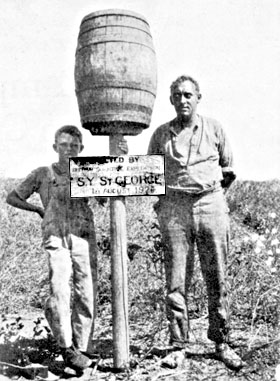
Using the largest motorboat, six men and a pilot are sent to inspect the situation on Floreana, the island that Randall originally had chosen for settlement. Meanwhile, negotiations begin with Alvarado and Cobos about acreage on San Cristóbal.
A party went over to Floreana to greet countrymen and to inspect the situation. Mate Gunnar Andersen from Nordstrand and the 12-year-old Rolf Pettersen from Oslo stand by one of the two mail barrels then at Post Office Bay. Photo courtesy Robert Ødegård.
Otto Stöcker serves as interpreter. The mate from Isabela was offered a foreman's job by Alvarado and stayed behind on the island when Bruun sailed the cutter to the continent a few days earlier.
Alvarado's offer is tempting. Each colonist will receive free 20 hectares (50 acres) of fertile land a few kilometers above Progreso. They were also promised credit of 200 sucres for services and merchandise, free rent for two years, together with the opportunity to engage workmen and draught animals cheaply.
There is a requirement that between each plot of land, 50 acres be set aside for Alvarado. Norwegians would have first right to these plots for five years, and the price is set at fifty cents per acre. At first the administrators think that Alvarado is trying to cheat them with this clause, but Stöker explains that this is the rule, according to Ecuadorian law. On the whole it seems that the island's most powerful man is generally interested in the well-being of the Norwegians.
Young Cobos makes an especially favorable impression when he reveals his admiration for the Norwegian bard, Henrik Ibsen. From Randall he borrows one of the poet's works in English.
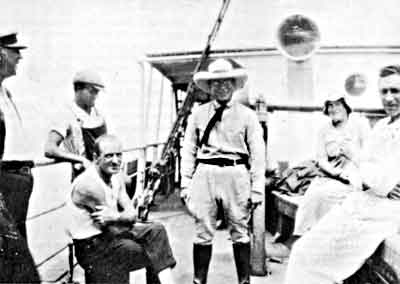
Manuel A. Cobos welcomes the Albemarle expedition to Galápagos. He strongly urges them to make San Cristóbal their terminal station. Photo courtesy Robert Ødegård.
A week passes before a final decision is made and they continue to live aboard Albemarle. Meanwhile, smaller groups move around on land and water to explore the conditions, to fish, and to observe the strange environment.
Molvin Knutsen from Ålesund is leader of the fishing group which keeps returning with exotic fish for dinner. When they have more than enough for their own use, they barter fish for meat and other commodities at the store in Progreso.
Sharks cause trouble for Knutsen and his men. These predators help themselves to the fish after they are hooked. Often the men haul only a fish head over the gunwale!
They shoot sea turtles with rifles before they realize that the reptiles must be caught alive as they otherwise sink or are lost. They also shoot a sea lion, but its flesh is not as palatable as the cheap beef available ashore.
The Albemarle people feel that Wreck Bay indeed deserves its name. On a shoal in the middle of the entrance to the bay rests the remains of the Turul, a large ship from Fiume, Austria. She had a large cargo of kerosene when the British sank her during World War I.§ So far attempts to salvage the kerosene have failed and the fuel continuously leaks into the bay. When the sea is calm, a thin rainbow-colored film covers the water in a wide circle around the wreck.
§ See the Ships Page for details and clarification of the fate of the Turul.
On the morning of November 11, the motorboat from Floreana returns and reports that everything there is dry and desolate. Only four Norwegians and some local workers remain in Post Office Bay.
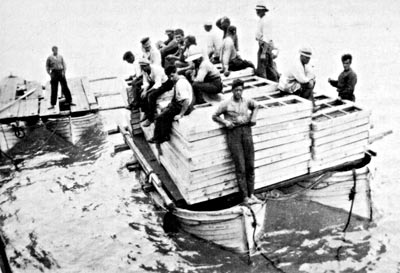
Santa Cruz Island they had not bothered to visit at all as they thought a place with only brackish water or catchment of rain water unacceptable.
The four lifeboats were tied together in pairs, and the work of unloading the 14 prefabricated houses could begin. Photo courtesy Robert Ødegård.
On their return they instead had an unexpected visit to another island. During the night the current carried the boat in the direction opposite to that estimated by the pilot. Hence they got an impression of Hood, an arid and relatively flat island south of San Cristóbal. This caused a delay of 24 hours and they considered themselves lucky in having taken along extra fuel.
At a meeting the same afternoon they agreed that if they are to settle in Galápagos, they must choose San Cristóbal where there is fresh water and at least some civilization. Another important reason for settling on this island is that the ship had only enough fuel for the return voyage to Panamá.
A large majority votes for San Cristóbal, their final destination: At last they can begin to unload the ship.
Randall breathes a sigh of relief now that his work is completed and his formal responsibilities over. For the time being, the mood is optimistic and in his favor. Now he hopes that the sale of the ship will be profitable and that everyone, including himself, can get back some of their investment. For lack of money before departure from Oslo, he had to put down 7,000 kroner for the ship, without receiving any shares or security. Besides, he has loaned a total of 1,700 kroner to various people aboard.
The unloading is done with two rafts, each made by joining two lifeboats with a deck of planks. This has been prepared in advance, and before sunset on November 11 they manage to get several loads ashore. But it proves to be more difficult than expected as the long wooden pier is so rotten that they dare not use it. Therefore, they cannot take advantage of the carts which run on rails from the end of the pier. Instead, they have to float the rafts as far up on the beach as possible, transfer the loads to carts in the water, and pull them up to a temporary storage on the beach.
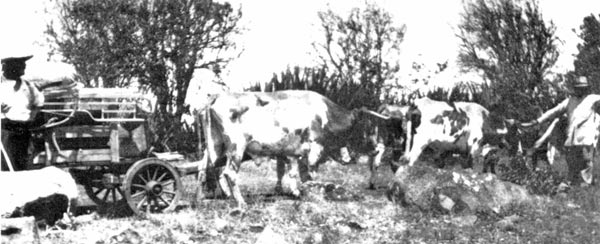
It was about 10 kilometers (6 miles) inland from the coast up to the plateau where Campo Noruego was to be established. To begin with, they used the tractor to transport equipment, but soon found out that it was cheaper and quicker to hire local men with teams of oxen to do the job instead. The carts were brought along from Norway. Photo courtesy Robert Ødegård.
This operation takes ten days to complete. Meanwhile, others have begun to clear land in the highlands. Every adult who wants land receives his registered 50 acres. Between each plot of land, space is left for roads.
Einar Austlid is assigned the responsibility of drawing a map of this new village of square plots and 14 houses. They have already decided upon a name: Campo Noruega.
When the equipment arrives, at first dragged by tractor, later by rented oxcarts, it is placed beneath a temporary tent. The tent material happens to be canvas from the polar explorer Roald Amundsen's balloon used in his Spitzbergen expedition. Randall had obtained it from his friend very cheaply. So far it has been used for awnings and shower tents erected temporarily on the deck of the Albemarle, as auxiliary sails for the motorboats, and eventually as tarpaulins and tent ashore on San Cristóbal—a fate under the Equator which Amundsen could hardly have imagined for his Arctic balloon.
Wednesday November 24 Albemarle sails back to Panamá with its regular crew and a committee to supervise the selling of the ship.
While everyone else has moved into tents or temporary cottages at the beach and at Campo Noruego, Randall has lived these past few days as a guest of Manuel Cobos, Jr. Once again, the relationship to some of the participants has worsened—just when one believed that all quarrels were settled. There are accusations of inefficiency and greed. Randall's former friends in the administration, Stray and Andersen, have turned against him.
This criticism is related to frustration and disappointment about the land which was to shape their future. They re-read the many articles on Galápagos, including Randall's small book about “The Norwegian paradise on South America's west coast.” They demand an explanation. What has happened to the South Sea paradise?
Some weeks later, when Axel Seeberg is back in Galápagos and meets the Albemarle people, he is also shown what has been written in Norwegian newspapers in the Spring of 1926.
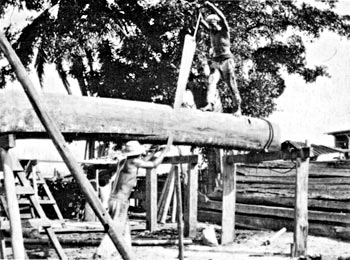
It is especially the newspaper articles in Tidens Tegn and Aftenposten, written by Aug. F. Christensen, that Seeberg finds incredible. Apparently he laughed until he cried, slapping his thighs, quite overwhelmed to think that anyone could describe the islands in such flowery terms.
The local matazarno tree was excellent for house construction, but trunks of this size are not to be found in Galápagos. Photo is probably of a mainland tree. Photo courtesy Robert Ødegård.
Randall cannot avoid becoming the scape-goat for those who feel betrayed. That he himself had been the object of biased information and thereby induced to paint a glorified picture of the archipelago's potential, may not be an adequate excuse. But that he was consciously cheating is most unlikely. If this were the case he would hardly have come along on the expedition and planned a coffee plantation for himself.
Randall cannot live and work among people who accuse him of cheating. He is deeply hurt by the criticism and decides to return home as soon as possible.
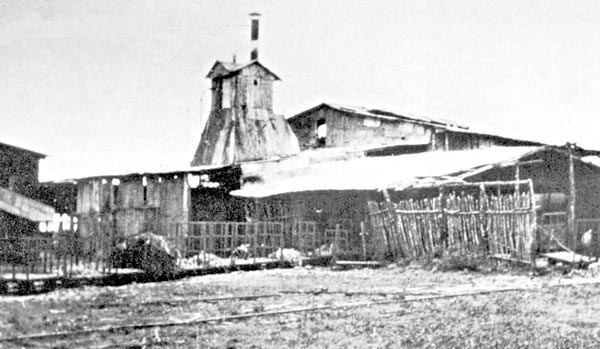
Like the rest of the village on San Cristóbal, the Progreso sugar factory was founded by Manuel J. Cobos. When it was built in the 1880s, the factory was very modern. Photo courtesy Nette Næss.
Martin Skaraas, who comes over from Santa Cruz to barter canned food and greet his fellow countrymen, provides this impression of the situation on San Cristóbal after a few month's activities:
“In this colony it is very lively. Not like it is with us where everything is peaceful, for here they fight every day. They have had trouble ever since they left Norway, and they have been terribly cheated. Hjorth relates that when they arrived here, Randall went ashore alone, met with Alvarado and Cobos, and without conferring with the others, arranged to receive 200 sucres for each contract that was made.
“Although here there are between 50 and 60 thousand wild cattle and thousands of pigs, they had to sign an agreement not to hunt but to buy meat from Alvarado. They were given land high up where nothing grows. Then there were protests, so that Alvarado had to grant land in the fertile belt, and now they have to dismantle the houses and move again. This is a terrible chore so most of them will leave. When Randall came aboard the ship to travel to Guayaquil†, they threw him into the sea, so he was obliged to live at Cobos' until the local schooner returned and he could go on the next trip. He dares not live on the island, as the Norwegians who are left would have shot him.”
† Skaraas makes a mistake; the ship returned to Panamá.
Randall indeed wants to leave, but—according Skaraas—the crew of Albemarle refuses to take him along. He has to wait until the next shipping opportunity eastward but takes the opportunity to get to know the island and its inhabitants. Skaraas' comments must be read with a certain amount of skepticism as rumors and gossip flourish in this community completely devoid of news media.
Randall enjoys a growing friendship with his host, Manuel Cobos. Every day they go riding together, and in the evening they play chess and talk. Cobos insists that Randall be his guest and stay in his house as long as he wishes. When Albemarle sails, Randall writes in his diary about his frustrations regarding some of the crew and expedition members:
“At 1 o'clock today, Albemarle left for Panamá with the following crew: Captain Deetjen who gets drunk whenever he is ashore; first mate Andersen, who drinks anything others pay for; second mate Lund, arrested by the police when we were in Las Palmas because of drunkenness and disorderly behavior; steward Lunde, former choir singer at the Opera Comique Oslo, an incurable and brutal drunkard who was arrested in Panamá; third mate Bjørnstad the same; he jumped overboard while drunk in Las Palmas; fully dressed and with his pipe in his mouth, he swam around the ship. As a result of that he developed pneumonia. Jørgen Bjørnholdt, disowned by his family on account of drinking. Guttorm Pettersen, also whenever possible went ashore and returned drunk and unable to work; he was paid off recently when, in his usual state again, he refused to work.
“Ship owner Stray gets dead drunk every time he has money; on our voyage he served as third engineer. Luckily, the two other engineers, Musikka and Stokkevaag, are decent people, as are the two assistants, but God forbid, what a crew!
“I do hope they find their way back. Moreover, K. Pettersen goes along as carpenter and member of the sales-committee. The other members are Stray and Andersen. When the ship left, some shots were fired from a revolver and a few rockets were sent skyward.”
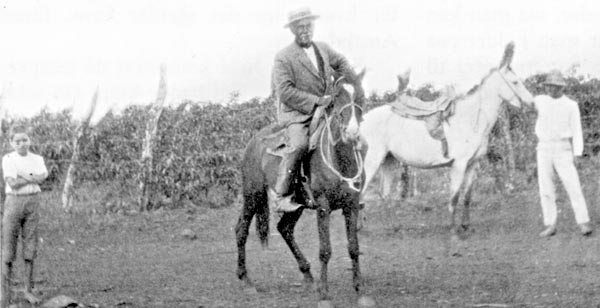
When Albemarle sailed back to Panamá, Harry Randall moved in with Manuel A. Cobos. Nearly every day he went riding with his host. Photo courtesy Sylvia Randall Andersen.
Randall has only about three weeks ashore, but stays long enough at Cobos' house to obtain a good impression of the daily life of the island's upper class. There is no lack of affection and friendship, but he is taken aback by the general disorder, lack of maintenance and poor hygiene. He is also concerned about the way the domestic animals are treated. Donkeys' saddles resemble wooden trestles turned upside down. Where the wood rubs against back and loins, the hide is often chaffed through, leaving large sores where flies abound. About the shops he writes:
“In the two or three company stores found here, merchandise is never wrapped. The buyer always has a piece of cloth at hand and wraps sugar in one corner, flour in the other, salt in a third, and corn in a fourth. At the butcher's, where cattle are slaughtered just outside, the meat is sold while still warm. The blood is lapped up by the roaming dogs and pigs, and when the animal is tied to be slaughtered, all the dogs in the village gather to partake of the feast. I found it so horrible to watch that I had to get away because I felt like fainting.”
The daily work routine and meals are also described. The servants' hygienic standard is unimpressive.
“Lack of cleanliness is simply comical. Instead of washing wine glasses, the cook empties the remains on the floor, dries the glass with his fingers or with a dirty towel and afterwards places it upside down, back on the table, which remains set day and night. The tablecloth is an oilcloth, tacked in place at least three years ago.
“Wine and spirits are always at hand. Walls and floors are not tight, air passes through the cracks, and when one sweeps the upper story, dust falls down into the office and shop downstairs. All kinds of dirty people come and go upstairs on different errands. The communal water toilet is in a room without a door, so one risks being interupted by a lady while in the middle of one's intimate business; therefore I prefer the green woods. Incidentally, whatever somebody does in the room can be heard all over the house.”
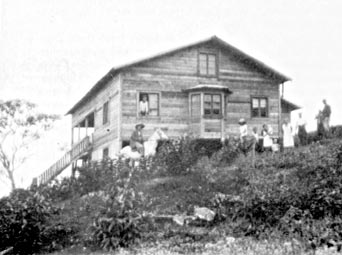
Two of the original Campo Noruega houses were later reassembled as one large house. Photo courtesy Robert Ødegård.
One may wonder what has happened to the high-class style described by Per Bang and Ludvig Næss. Possibly it has something to do with the eyes of the beholder? Nevertheless, Randall has a splendid time thanks to his amiable host. He begins to regain some of the 10 kilos (22 lbs.) he lost during the voyage. And he sleeps well. The only thing that keeps him awake is when the 200 or so village dogs fight beside the house. But no one else seems to be bothered by the ear-splitting noise.
On December 3, Harry Randall leaves Galápagos a bitter man. He still has plans to establish a coffee plantation on his 50 acres, but since it takes four to five years before one can begin harvesting, he hopes that with Cobos' help, he can initiate his project while remaining in Norway.
In Guayaquil, therefore, he pays a visit to Governor Ribadeneira to acertain if the contract with the landowner Rogerio Alvarado will be honored. But the information which Randall receives makes him stare in disbelief at the governor. According to Ribadeneira, Alvarado never owned either the cattle on San Cristóbal or the land at Campo Noruego!
The 14 houses on San Cristóbal are not ready for occupancy until after the New Year. Considering that they not only have to be constructed, but first be transported, bit by bit from Albemarle to the beach, and thereafter be drawn by oxcart 10 km up to the highlands, partly over roadless terrain, it is a remarkable accomplishment to have built all the houses within 2 months.
As the work progresses it is marked by festivities. Einar Austlid writes as follows:
“One house group had a garland party when the rafters were up. They had purchased a sack of sugar, brewed and distilled it. During the evening they came like a herd of oxen, hooting and shouting, from house to house, and offered their ware. It was a noisy crowd, like New Year's Eve in Old Norway. The locals thought the devil had arrived and was finishing off most of us!”
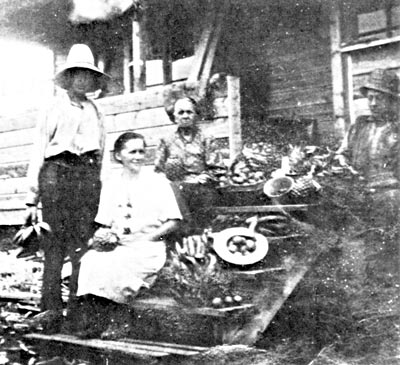
As on Santa Cruz Island, as soon as the contracts are signed, land is cleared and crops planted.
Karl and Ragna Aune from Malvik display a selection of exotic fruits and vegetables. In the background is Karl's 73 year old mother, Kirsten. To the right is Einar Austlid, a teacher from Ørsta who lived with the Aune family in the newly-constructed house at Campo Noruega. Photo courtesy Einar Austlid.
With Christmas approaching at Campo Noruego, one would have expected to see vegetables in the various fields, but this is not the case. They realize that local conditions are unsuitable for Scandinavian seeds. If anything sprouts, it attracts a small red ant, which seems to thrive on Norwegian crops. Valuable corn produces next to nothing. Only tomatoes thrive, but they in turn are very popular with the island's many wild pigs.
The first potato harvest also is the last one. Austlid writes that “potatoes are no bigger than gooseberries, and other vegetables have not come up at all. Only yucca is thriving.”
Yucca is a tuber which can be served as a vegetable, or can be grated, dried and made into flour. But most of the settlers are not willing to change their traditional eating habits, and neither yucca nor other local crops are popular. This is a major reason why so few Norwegians succeeded as farmers.
Drinking, which was a problem during the voyage, continues to be an embarassment for the colony, although it is only a small hard-core group that is responsible for transgressions. Strangely enough, nobody is killed or seriously injured during drunken brawls and shooting practice.
Nevertheless, the San Cristóbal colony experiences one death during the first year. Kirsten Aune contracts dysentry and dies at nearly 74 years of age. On the other hand, two babies are born. The first little Norwegian sees the light of day on Galápagos on January 9, 1927, and is given the name Erik. The parents are Eugenie and Arnulf Greiner from Kirkenes, a small town north of the Arctic Circle.
Expeditions that were never realized
The Floreana, Ulva, Alatga and Albemarle expeditions had at least one thing in common, they got underway.
While Galápagos fever ravaged among the unemployed willing to travel, there were many others who planned on buying a ship and sailing off to the “Norwegian Paradise on the South American West Coast.” Four of these expeditions were reported in the newspapers. However, no journey ever materialized although in one case members moved aboard ship and were ready for the voyage.
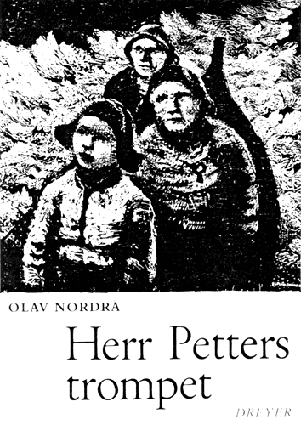
In the 1964 book Mr. Petter's Trumpet, author Olav Nordrå recalls how, in 1926, he and his parents rowed and sailed in an “åttring”—a small eight-oared undecked boat—south from Helgoland in the county of Nordland in northern Norway. The plan was to join one of the Galápagos expeditions. During their slow and hazardous trip along the coast, they heard rumors to the effect that the expedition was troubled by fraud and deception. As a result, they abandoned their effort in Trondheim! The title of the book refers to a beloved Nordland poet, Petter Dass (1647-1708), who in his great epic Nordland's Trumpet, has the following verses of inspiration. (In Norwegian, the lines rhyme.)
In our area we produce neither grapejuice nor wine,
in our mountains and hills silver ore is not likely to be found.
We have no goldmines red.
Because we do not live in the land of Canaan
where milk and honey flow like water,
by us there are no grapes for picking.
They shouted and made a terrible noise;
we need to borrow, we are starving to death,
our stores are severely depleted.
And if you do not alleviate this our emergency state,
then you force us to go and pawn the very last of our belongings.
And this is exactly what they did—as did so many others who wanted to go to Galápagos. The cover illustration is by another Northland man, Kaare Espolin Johnson.
The Hedvig Project
In the Tønsberg newspaper of March 15, 1926, there is a report of a marine lieutenant Dehli who has purchased the 800 ton motorship Hedvig. She is berthed in Moss and will combine transport of immigrants with a cargo of dynamite destined for northern Chile. One month later, Hedvig is also mentioned in a note in Sandefjords Blad but later nothing is heard of her.
“One expedition after another…”
Sandefjord's newspaper June 14, 1926:
“It will surely not be long before the Galápagos Islands are overpopulated by Norwegians if the Galápagos fever lasts much longer. Sandefjords Blad received news today that a new expedition is being prepared for the popular islands. Leaders will be O. A. Olsøn Lunde and Captain Bornholt of Oslo.
“The expedition will be ready to leave on the first of August. There will be about 80 members, several of whom will be accompanied by their families. This expedition will also take along equipment for a canning factory. The expedition has secured a first class steamer of about 1300 tons.
“One expedition after another is organized and thousands await their turn. As long as one stays with the man who first started these expeditions, all should go well. But it appears to us that too many leaders of diverse qualifications show up. Galápagos is no Klondike.”
True enough. This last comment is probably a quote from the Ecuadorian consulate, i.e. Christensen's office, and it is no surprise that Aug. F. himself is worried about the situation. Consul Bryhn has issued a warning to the Foreign Office that the Floreana expedition is in deep financial difficulty. What later happened to Lunde and Bornholt's ambitious plans is not known. Most likely a financial reassessment made it clear that an individual capital investment of 3000 kroner was unrealistically low.
Eilertsen tries again
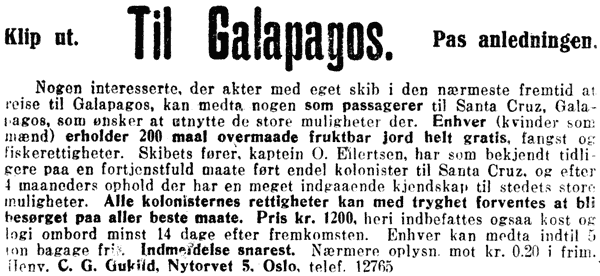
Cut out. To Galápagos. Watch for the opportunity.
A group, who in the near future plans to sail to Galápagos in their own ship, can take a few persons as passengers to Santa Cruz, Galápagos, in order to exploit the considerable opportunities there. Every person (women as well as men) is given completely free 200 maal (50 acres) of extremely fertile land, as well as hunting and fishing rights. Captain of the ship, O. Eilertsen, as is well known, has earlier successfully guided some colonists to Santa Cruz, and after a 4-months stay there, has gained a detailed knowledge of the region's great opportunities. The rights of every colonist can safely be expected to be taken care of in the best possible way. The cost is kr 1200, which includes full board and lodging aboard the ship for at least 14 days after arrival. Every person may bring up to 5 tons of luggage free. Join quickly. For more information, send kr 0.20 in stamps to C. G. Gujkild, Nytorvet 5, Oslo, tel. 12765.Olaf Eilertsen's return home caused a lot less fanfare than his cheerful departure. Østlandsposten of March 10, 1927 has the following short note:
“Captain Eilertsen, who left this Spring with the Ulva expedition, came back on Monday aboard Kong Dag from Hamburg. He is apparently trying to find a vessel with which to sail to South America to engage in coastal trading and possibly establish a route between the continent and the Galápagos Islands.”
We do not hear more about Eilertsen's new plans until the month of May. Saturday May 7, 1927, Tidens Tegn reports the following:
“Preparations are now being made for a new expedition to the Galápagos. Leaders of this project are Captain O. Eilertsen, who last year led the Ulva expedition to Santa Cruz, and C. G. Gukil.
“The plan is to buy a steamship which can accomodate some passengers. A cooperative enterprise, such as in previous arrangements, is not being contemplated. A ship has not yet been purchased because they want to see what the passenger response might be.
“The expedition will stay a while in the Galápagos Islands in an effort to generate coastal trade between the islands and the continent. Should a larger ship not be suitable for this kind of transportation, the purchase of a motorschooner of 100 to 150 tons will be considered. The intention is to establish a market which has a regular supply of Norwegian products, since it is well known that one of the most difficult problems is the lack of regular contact with the continent.”
After May 1927 we find no more newspaper reports about Eilertsen's new expedition. But the plan for a 100 ton freighter was sound; the previous ships had been too large and too expensive to operate. Eilertsen still feels responsible for his friends on the islands. He doubts that Bruun's small sloop alone can adequately handle freight to and from the colonies. In late October, he had personally witnessed how a rather small load of canned goods shipped by Bruun to Guayaquil was affected by sea water. Several cases were damaged by rust and had to be sold cheaply. Future transport of bacalao would be in vain if the products could not be stored under absolutely dry conditions.
It is Gudrun Eilertsen who persuades her husband to abandon all future Galápagos plans. She is happy to have her husband home and alive, but is also worried about his mental health. He is depressed, has problems of concentrating and again suffers from severe headaches. That the economic situation is poor does not improve his condition. They agree that the family will have to endure scandalous gossip in their home town rather than start getting involved in new and stressful projects.
(For the next few years it is Gudrun Eilertsen who provides the family income while her husband is unfit for work because of his nervous condition. Their two small sons are teased and nicknamed “The Galápagos boys.” Gudrun earns most of her income as a dressmaker, but in 1934, this remarkable women receives the Coastal Master Certificate in Sandefjord, becoming the first women to do so. She receives a grade of 2.90, i.e. excellent! However, she never actually works as a coastal skipper. Olaf Eilertsen's condition has slowly improved and he is now employed as captain on the coastal liner Anna N. from Larvik, a position he retains until his retirement. Once more he is one of Larvik's respected men. In 1954, when he celebrates his 75th birthday, Østlandsposten has a very favorable article about him.)
Robinson Crusoe
Sigvald Strømme was a lawyer and real estate broker in Oslo. Apparently he planned to join Harry Randall's expedition before settling in favor of his own enterprise. He invited investment in a cooperative company, patterned after Randall's model, and soon received 500-600 applications. At the end of May 1926, when he had 60 members committed, he and Captain T. Gundersen Welhaven bought the sister-ship of Albemarle, the 1000-ton ferro-concrete ship Fjeldtop. Like Randall's, Strømme's expedition was to sail in July.
It was decided to equip the ship in Porsgrunn. This is some distance south of Oslo, but Moss, Tønsberg and Larvik were all busy with other Galápagos expeditions, and Vippetangen quay in Oslo was reserved for Randall.
The name Fjeldtop (“Mountain top”) was changed into something more appropriate for an expedition ship sailing from Norway to the Pacific. It was re-christened Robinson Crusoe!
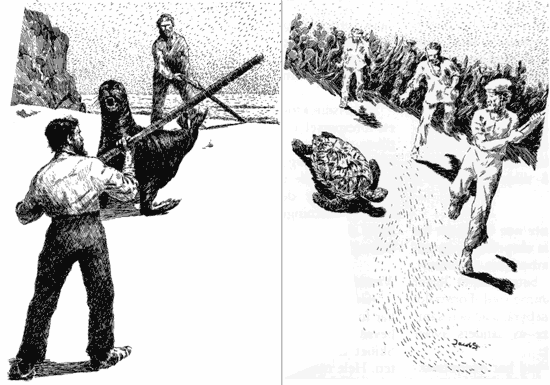
The abundance of wild pigs and cattle―or as shown here, turtles and sea lions―were fascinating features. Drawings by Jacob Sømme in Alf Harbitz' book Mandskapet fra Bark “Alexandra” (The Crew of the Barque “Alexandra”).
Problems and delays follow in turn like pearls on a string. By the beginning of September Robinson Crusoe is still moored in Porsgrunn harbor. The number of members has increased to 80. Since August, thirty of these have lived aboard ship to help with preparations, and simply because they have no other place to live.
The plan now is for the ship to sail at the end of the month. On Wednesday September 8, the Porsgrunn Dagblad has a report on how the expedition is faring:
“Yesterday one of P. D.'s reporters made a call on Captain Gundersen Welhaven and confronted him with Consul Bryhn's warning about leaving for the Galápagos. However, the captain responded by presenting a report dated December 15 of last year and signed by Consul Bryhn, in which he praises Galápagos and Ecuador in glorious terms and confirms that on the islands they grow bananas, oranges, etc.… and most types of grain. There is fine pastureland suitable for raising cattle. The climate in the islands and the highlands is extremely pleasant and healthy. The statement finally declares that hardly a country other than Ecuador and Galápagos can offer such good opportunities. This contradicts recent statements by the Consul, the captain points out, and we find his conduct strange. Meanwhile, we shall depart in good spirits because the reports which arrived from earlier expeditions are satisfactory.”
At the same time that the reporter of the Porsgrunn Dagblad interviews the captain aboard Robinson Crusoe lawyer Strømme, in an Oslo court, is accused by the Department of Social Services and the Oslo Police of breaking emigration rules. In May he had received several complaints about irregularities, as did Randall, but the lawyer argued that since the first expedition was not stopped by the police, he refused to change his plans. Thus he chose to have his case tried in court.
According to the Social Services Department the law ruled that in order to act as an agent in matters of emigration, written permission from the police was required. The purpose of the law was to assure that emigrants arrived safely at their destination with a minimum of problems. Among other things the agent should have had full understanding of facilities and opportunities in the country of destination.
The Department goes on to explain that this expedition has neither a detailed statement nor a plan, including how money is to be managed. The Department declares that Strømme not only has taken the initiative for an expedition, as he insisted, but also has taken a decisive step, because he let people sell home and farm. Unlike Randall's expedition, there is no detailed statement about this matter, there is no plan and a minimum of documents. It is not known who is responsible for the money. “Strømme is everything—the others nothing.”
To everybody's surprise, Strømme is acquitted. He also receives kr. 100 in compensation.
Now there should be nothing to hinder Strømme from taking his expedition and sailing at the end of September, as announced. But Fall soon passes with the concrete ship still in the same place. Originating from Myhre's News Agency, the same article appears in several of the country's newspapers on Tuesday November 30:
“Since August, lawyer Strømme's ship for his Galápagos expedition, the Robinson Crusoe, has been moored in Porsgrunn. The expedition consists of 30 persons; family providers, women and children 4 months of age and older. There are only a few kroner left of the capital contributions, and since the purpose was to emigrate to the tropics, the members have sold everything that is needed for wintertime and at present they are without means to cope with the future.
“A request is made to the Social Welfare Department for State assistance in one form or another. Meanwhile they will try to use the ship as a freighter during winter, with a departure for the Galápagos possibly in the Spring.
“Director Welhaven of the Social Welfare Department confirms to Myhres News Agency that the expedition participants have applied for help and that the issue is being considered. But in a situation like this, there is little likelihood of obtaining support; one must be prepared for a rejection. The Emigration Law is currently under review in order to protect participants of expeditions like the one in question.
“The Norwegian Directorate of Shipping and Navigation informs this agency that one cannot issue a sailing permit for a freighter unless there is a sufficient number of officers aboard. One has to provide a captain, a first mate and an engineer, in addition to a couple of able bodied sailors among the crew. Up to now there are none. The ship, which is built of concrete, has been inspected and is in good condition.”
Vestfold Fremtid, December 2nd:
“The Galápagos ship Robinson Crusoe has left Porsgrunn. There is great secrecy about its departure. For the time being, the ship will sail as a freighter along the coast. The entire crew, women and children, are aboard. The expedition's leader will provide no information about future plans or the ship's destination. It is possible the ship will sail to the Galápagos in the Spring. The participants have settled all debts in Porsgrunn.
“According to news from elsewhere, the ship left for Fredrikstad, where she is berthed and will receive coastal cargo. Some of the women and children aboard were sent ashore in Porsgrunn and those remaining aboard will leave the ship in Fredrikstad, where in the meantime, living facilities are provided. The idea was to keep the ship busy during the winter with the help of the 12 male members of the expedition, so that they could provide for their families left ashore.
“Initially, the ship sails with empty barrels for Bodø, north of the Arctic Circle!”
One week later, another story about the scandal in Porsgrunn appears in the newspapers. The expedition members themselves have charged Strømme with fraud, and all relevant documents have been sent to the public prosecutor.
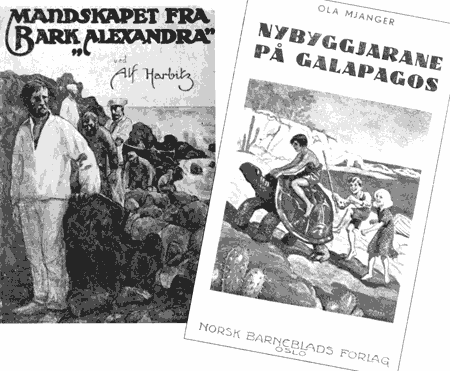
Two books that describe the Norwegians' adventures in Galápagos: Alf Harbitz' The Crew of the Barque “Alexandra” (1915) and Ola Mjanger's children's book Settlers in Galapagos (1936).
One person—a single man—from this expedition finally arrives in the Galápagos. He worked his way across the Atlantic, through South America, and eventually arrived in Santa Cruz in February, 1929. His name is Johansen.
Like Floreana, Santa Cruz gradually becomes depopulated. Even Johansen is unable to stand it for long. We do not know his first name, or where in Norway he originated, but on Santa Cruz he becomes immortalized with the nickname “Grise-Johansen” (“Pig-Johansen”). The story goes that he kept Norwegian pigs in a corral and let them run free when he left.
The pigs thrived and by the 1930's they had become a large and feral herd. For a long time they were an important food resource for Norwegians and other immigrants, especially the boars weighing 200-300 kilos (400-600 lbs.) and armed with huge tusks. These feral swine are fierce animals that show little resemblance to their domesticated ancestors.
Except for the story about “Grise-Johansen,” it has been impossible to trace the fate of the other 30 unhappy persons who lived aboard Robinson Crusoe in Porsgrunn harbor for 3 to 4 months in the Fall of 1926.
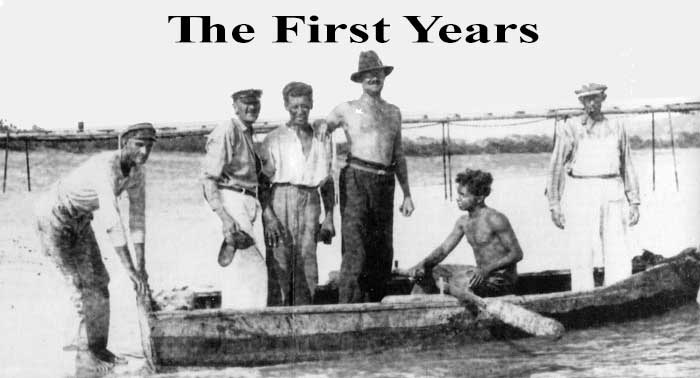
At Post Office Bay, 1927. From left: Kristian Stampa, Paul Bruun, Henrik Lund, Thorolf Østmoen and Karl Pettersen. Seated rower is unidentified. Photo courtesy Robert Ødegård.
Between the summer of 1925 and the Fall of 1926 the human population on the Galápagos Islands grew from about 400 to about 550 persons, an increase of nearly 40%. The 150 new settlers were Norwegians who experienced a long and painful voyage to reach their destination. For all intents and purposes, they were financially hard up, but they were healthy and had their belongings intact. If Galápagos had really proved to be the paradise that they were led to believe, then our story about the Norwegian immigration would have ended with “…and there they lived happily ever after.” The remainder of the story would have been too boring to justify space between the covers of this book.
But it did not happen this way. For most of the Norwegians the voyage had hardly begun. These people would be dispersed over all the mighty American continent, from Argentina and Chile in the south, to Alaska and Canada in the north. Some also moved to Australia and Africa. Here they found work, friends and excitement, maybe a sweetheart and a permanent home. Others found an all too early grave. Many returned to Norway after a shorter or longer period of time.
It is interesting to note, however, that of all those who gave up the original plan for a Galápagos future, only a few remember their stay with bitterness. The Galápagos expeditions were good adventure, in spite of everything else.
Some were firmly committed to not give up. They thrived on life's harsh demands on these palmless, sun-dried islands in the Pacific. There were not many, and the few became fewer each time Galápagos revealed itself not only as an enchanted, but a rather bewitched and cursed place, which claimed her victims mercilessly.
Before three years had elapsed, there were three crosses with Norwegian names marking the graves at Academy Bay on Santa Cruz Island. Additionally, we have the following gloomy statistics for 1929 concerning the fate of the Galápagos expeditions:
From Floreana no one remains.
From Isabela; only Paul Bruun, who is now skipper aboard the local schooner Manuel J. Cobos.
From Ulva; Gordon Wold and Kristian Stampa. They fish together from their base at Santa Cruz, but also live part time on Floreana.
From Alatga no one remains.
From Albemarle; Thorleiv Guldberg with daughters Karin and Snefrid and the couple, Ruth and Alf Ødegård. Of the former fishing party only Trygve Nuggerud and Erling Jenssen remain.
And Johansen from Robinson Crusoe has freed his pigs and has also left. So only nine of 150 persons of the original expeditions settled in Galápagos, ten if we also count Bruun.
What is the reason for this development? Let us look back to the Fall of 1926 and the activities in the three Norwegian colonies on Floreana, Santa Cruz and San Cristóbal.
Floreana
In the autumn of 1926 the fate of the Norwegian colony at Post Office Bay is already sealed because of the isolation, lack of water, and a hopeless economy—the men will return home. In early November, Axel Seeberg cables from Guayaquil to Sandefjord asking for travel funds for eight persons. Some of these eight are former crew members of Floreana, which was recently sold in Ecuador to a Colombian shipping company. Three or four men remain at “Casa Matriz” to take care of the company's property, waiting for the whaling expedition Atlas to arrive. But faith in Atlas weakens gradually. This whaling factory ship was expected in February, now seven months past, so they eventually decide they may as well sell the little steam engine from the electric plant to the factory at Santa Cruz. As a result, the Floreana colony loses its old luxury—electric light.
When Seeberg and Bruun arrive with Isabela on Christmas Eve, 1926, they bring parcels and mail from home, tobacco and provisions, even beer and liquor, but no good news about Atlas. Christmas sentiment takes on the mood of a funeral.
Those few remaining from the Floreana colony sail with Isabela to Santa Cruz to celebrate New Year. Some days later, in January 1927, the last members of La Colonia de Floreana leave Galápagos.
Occasional attempts to settle on Floreana during the next two years are unsuccessful, and after August 1928 there are no human beings; only memories are left of the first Galápagos expedition from Sandefjord.
On Thursday April 7, 1927, Vestfold Fremtid prints the following story across its front page:
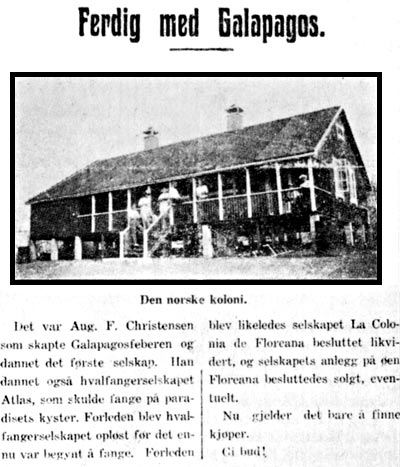
“Finished with Galápagos”
“It was Aug. F. Christensen who started the Galápagos fever and formed the first whaling company Atlas, which was to be hunting off the paradise's shores. Recently the whaling company was dissolved before it had made a single catch. Also of late, the company, La Colonia de Floreana, decided to wind up its affairs, and has decided to sell its land on the island of Floreana. All that remains is to find buyers. Make an offer!”
From the April 7, 1927 Vestfold Fremtid (“Vestfold Future”). There is a subtle tone of mischievousness in the little article, which is translated above.
That the labor party newspaper Vestfold Fremtid displays a jeering style, while the conservative Sandefjord Blad does not mention anything, is hardly coincidental. Naturally enough, Aug. F. becomes unpopular among his friends who are left holding worthless shares. In a scrapbook and a photo album he keeps the memories of the exciting experiment to himself, and otherwise talks very little about his personal involvement with the Galápagos project.
Christensen continues until 1935 as Ecuador's consul in Norway. This year he turns 50, an event that is noted in newspapers all over the country, but nothing is said about the Floreana expedition. Later he does much traveling, lives for a while in Spain and Morocco, and participates in the drafting of maritime laws for Ecuador. In 1940 he apparently earns a doctorate in political science at Western University in Delaware, USA. After World War II he settles in Åsgårdstrand where he becomes mayor and is still remembered as the instigator of the “Åsgårdstrand Days.” †
† Åsgårdstrand Days is an annual summer festival in this seaside village and popular summer resort near Horten in Vestfold. The painter Edvard Munch lived here.
Aug. F. Christensen dies in 1959. His length obituary mentions nothing about the Floreana expedition.
Axel Seeberg was now given the responsibility of selling the remaining installations on the island. Seeberg in many ways resembled the skipper of Isabela, Paul Bruun. He had the same education and was about the same age. He is also remembered as a person of exceptional charm and imagination, full of ideas and visions; extrovert and original. He wrote poems when he was inspired, and was the life and soul of any party.
Contrary to Bruun, Axel Seeberg has nothing in Norway that he wanted to escape from, but in 1926 he becomes involved in a network of unfortunate circumstances in Ecuador. With his strong commitment to Floreana as a commercial whaling station, he is shocked to learn that the company is dissolved. When this bad news reaches him in March of 1927, he has accumulated a sizeable personal debt in Guayaquil. And it continue to grow.
He clutches at straws hoping to sell Casa Matriz † and other valuables on Floreana. For him this is a difficult task, especially regarding the house. It was he who in 1925 personally supervised its construction using the same design which he employed when building a house for his family and himself on the island of Hvalø near Tønsberg 14 years earlier.
† Casa Matriz still existed as recently as 1966, but today (2006) all that remains are a few cement foundation pedestals, which may be seen beyond the Post Office barrel on Isla Floreana.
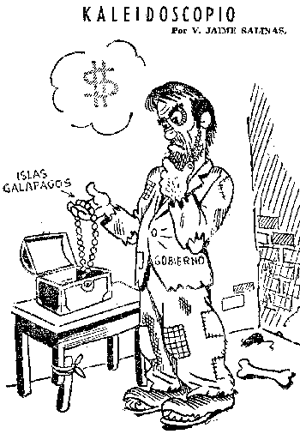
But the authorities interfere. Some of the original conditions have not been fulfilled. Among other things the company committed itself to build a better pier, a lighthouse and a governor's residence at Post Office Bay. Failing to do so, all the company's properties would revert to the Ecuadorian state!
With the frequent changes in government, much can be “arranged” through contacts and bribes. But as he cannot find any potential buyers, Seeberg will have to abandon this tactic as well.
Ecuador's economy in the 1920s and 1930s was extremely poor. Still, the ever-changing governments resisted the temptation to sell or lease Galápagos to the USA. However, Axel Seeberg and other Norwegians were hoping that this indeed would happen so that communication and trading facilities would improve. The cartoon by Jaime Salinas below the “Kaleidoscope” heading is from a 1939 Guayaquil newspaper, but illustrates a situation also prevalent a decade earlier. The cartoon is captioned “Temptation: Necessity is bad counsel.” Courtesy Jacob Worm-Müller.
What about Isabela? The old pilot sloop that he personally purchased in Norway belonged to the company. Because his debt was accumulated while working for the company, Seeberg feels that the boat should be his to use, either for carrying cargo like Bruun does, or for raising cash by selling her.
Bruun refuses. Did he not personally finance repairs at Madeira, Colón and Guayaquil? Without his support the sloop would never have arrived. Now that the company is dissolved he cannot recover his expenses either—hence the ship belongs to him!
Seeberg contacts a lawyer and reports Bruun. In August, after only ten months of freighting, the sloop is confiscated and Bruun is forced to stop his activities. The Isabela remains locked up in the harbor and starts to deteriorate.
By February 1928, Bruun has won two legal challenges but Seeberg will not consent and appeals to the highest court.
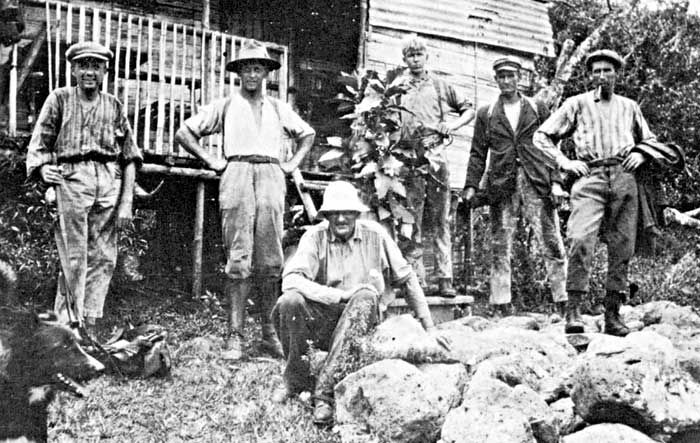
From “Camp Morten” on Floreana. Bruun is in the foreground. Photo courtesy Robert Ødegård.
The dispute over Isabela does not seem to undermine the friendship between Seeberg and Bruun. Between legal maneuvers and sales negotiations in Guayaquil, they play bridge together almost daily. One evening Seeberg does not arrive as arranged, but when he turns up next day, he relates how he had to spend the night in jail! The reason for his detainment concerns unpaid hotel bills totalling 750 dollars—about 3000 Norwegian kroner—a significant amount in 1928. The man who arranged Seeberg's release is Arthur Worm-Müller from Albemarle, and newly-appointed Norwegian Vice Consul. Consul Bryhn, residing normally in Quito, was so tired of all this travelling between his home and Guayaquil to attend to the multitude of Norwegians' problems, that he arranged to have Worm-Müller as his assistant.
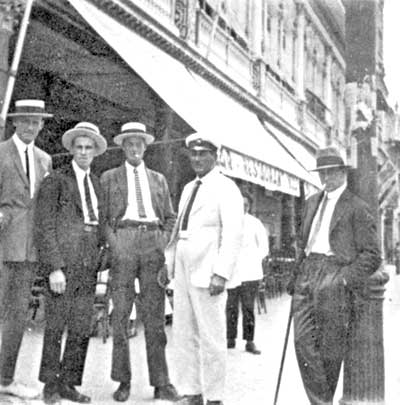
Seeberg's luck is running out. Previously so accustomed to success, what has happened to bring about this change? Everything is in disarray and one disappointment follows another. A third and final court decision assigns ownership of Isabela to Bruun.
But now the sloop is so worm-eaten below the waterline and so cracked above that she is unsuited for cruising between the islands.
November, 1926. Captain Axel Seeberg (in white suit), with other Norwegians in Guayaquil. Photo courtesy Netta Næs.
Throughout 1928 Seeberg commutes between Guayaquil and Quito, in fruitless discussions with consul Bryhn and other influential people in hopes of raising money. He not only wants to cover his personal debts but also hopes to buy the canning factory at Santa Cruz which is now up for sale. But in vain, it proves to be impossible to raise sufficient capital.
On the night of November 4, 1928, Captain Axel Seeberg, 58 years old, tumbles down a cliff in Quito and is killed. He is buried in the San Diego Cemetery in Quito, 2800 meters above sea level and 8500 kilometers from his children, his wife Helga, and his beloved home in Hvalø.
Santa Cruz
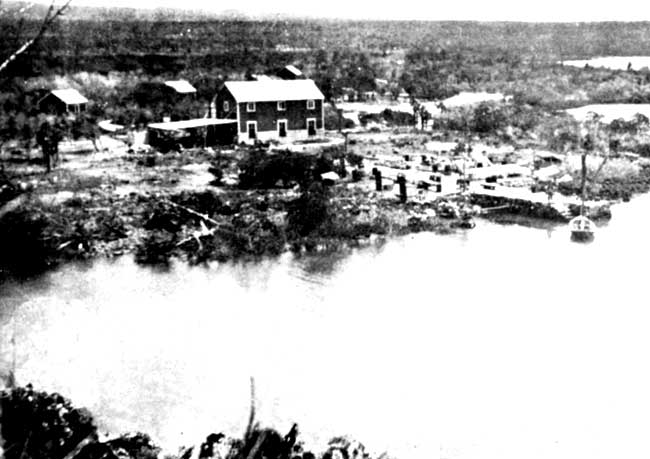
New Year, 1927. Academy Bay at high tide. At the end of the “Ulva” pier stands the tree trunk used as a crane. Leading to the factory is a rail track. The baking oven is hidden behind the factory. The open area is “The Square.” Courtesy Jens Furunes.
For about five months after Ulva first anchored in Academy Bay in August, 1926, there was, generally speaking, unity and excellent cooperation among the colonists. The production of canned food and dried fish continued right into November, 1927, but throughout this period there was an increasing amount of practical problems and internal friction.
The tasks that were accomplished during these fifteen months are quite impressive. From the beginning of construction in August, priority work projects included a quay and the laying of a pipeline from the source of brackish water to the construction site. The spring was located at the inner shore of Pelican Bay; so the installation required all the 400 meters of pipe brought from Norway.
It was the engineer Torstein Eig and the carpenter Henrik Furunes who effectively supervised the building of the factory and the seven small houses, each designed for four people. Borghild Rorud was content to live by herself in a tent with her botanical specimens.
At the end of the pier the men erected a giant tree trunk to serve as a crane. The tree† must have been of an unusual sturdy kind because it continued to stand on the Ulva pier as a silent monument until 1980, serving as a lamp post.
† Locally called “matazarno”—Piscidia cathargenesis.
By means of the crane, fish and turtles were hoisted from the boats, placed on a trolley, and pushed on rails to the factory. When there was a good catch, the factory was busy far into the night with men working in continuous shifts.
Spiny lobsters were caught under rocks at low tide, so most would be found around new and full moon when the ebb tide was at its lowest. In the beginning, catches were enormous, each man returning with 20-30 lobsters after one hour of work. Spiny lobsters lack claws and therefore cannot pinch, but they have a shell studded with stiff pointed spines. A pair of thick gloves was all that was needed for safe catching.
Lobsters could be kept alive in traps for some days, but lisa (mullet) and tortuga (sea turtle) had to be canned as quickly as possible. They also tried to can the large groupers, but the flesh was too coarse and turned an unappetizing color. It was best suited for eating fresh or preserved as “klippfisk”† —the popular salted and sun-dried bacalao.
† Klippfisk is fish originally dried on rocks (“Klippe” means large rock) but has come to mean any type of dried fish. In Norway most of the dried fish is Arctic or coastal cod, but the coalfish, a close relative of the cod, is also used.
Originally the tractor was parked beside the factory and by means of a belt drove an electric dynamo and the large stamping machine, as well as other machinery. It made a terrible noise and used a lot of gasoline. The problem was solved in November when the quietly-running steam engine was acquired from the Floreana colony. There was no lack of wood fuel on Santa Cruz. Now the tractor was freed up for other jobs.
Behind the factory, a large baking oven was built with bricks. Originally, Kristian Stampa was responsible for the important job of baking bread, but he also proved to be an able fisherman and craftsman, and the bread making job was reassigned to others. As with all other cooking responsibilities, baking was not very popular. When on a trip to Guayaquil aboard Isabela, Skaraas and Urholt hired two local cooks. To find someone on San Cristóbal who could cook European-style food was impossible.
There was great rejoicing when the two cooks arrived in Santa Cruz at the end of May, although Skaraas had to listen to comments on how they should have engaged someone with a lighter skin color: one was as brown as a native American, the other one “as black as pitch.”
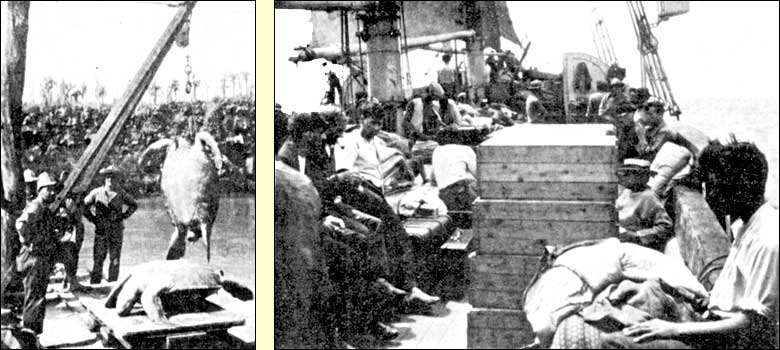
Left: Turtles were hoisted from the boats and pulled to the factory on a trolley. Lars Karterud is standing front left. Photo courtesy Ingeborg Faller Mjelde.
Right: When Ulva sailed to the continent after two months in Academy Bay, the first batch of canned food was ready for sale. Sixteen cases, each containing 96 cans, were sold in Guayaquil. But unfortunately for the colonists, profits equalled expenses. Photo courtesy Robert Ødegård.
Below: Bacalao (dried cod fish) was prepared from large groupers. It brought a good price in mainland Ecuador, especially during the Catholic fast before Easter. At left the youngest member of the expedition, Rolf Halvorsen from Larvik, born in 1910. Photo courtesy Thelma Lea.
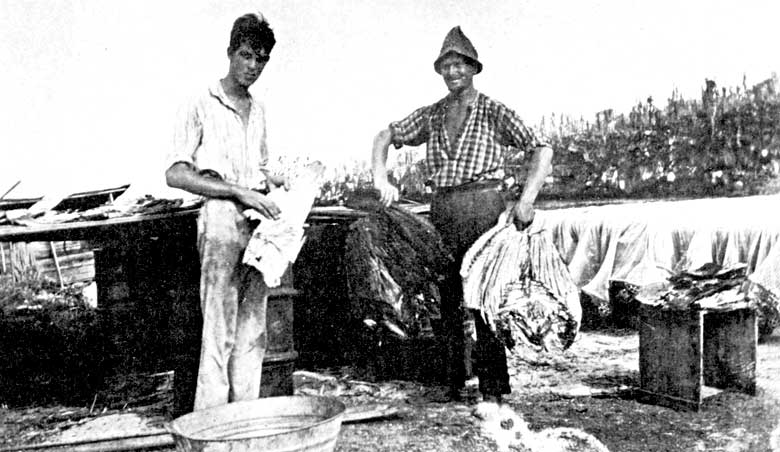
Around the factory and the seven small houses, they cleared land and planted. Between the houses were paths edged with lava rocks. A large area was kept clean and level and served as a square and a crocket court. Otherwise the second floor of the factory was the place for meetings and indoor entertainment.
Mathias Breivik had a balloptikon, (epidiascope) a device for projecting drawings and photographs on a white cloth. Such picture-show evenings were popular, provided there was a little energy left. This would mostly be on Sundays and holidays, the ordinary workdays usually left them with too little free time and strength.
As for farming in the highlands, the Norwegians had unexpectedly good luck. From the local workmen, who were left behind by the Ecuadorian of Spanish descent, Baquerizo, they took possession of a well worked plantation at Fortuna (former name of Bellavista). In addition, they also found two long since abandoned and overgrown plantations, called Santa Rosa and Cherla Chacras. At Santa Rosa they harvested crops like yucca and otoy, as well as sugarcane, maize, papaya, plantains (a type of mealy banana used as a vegetable), and ordinary sweet bananas. At Cherla Chacras were oranges and other citrus fruits. However, it took five hours each way on an overgrown path to reach these plantations.
It was gardner Rambech who cultivated and cleared new land at Fortuna. Initially, he received help from the agriculturists Bechmann and Nielsen and later, at the end of January, from the Alatga-man, Sigvart Tuset. Until November, Rambeck and Tuset were the best of work-mates and friends, and pursued a fairly solitary but happy existence in the highlands.
But it was a strenous life. They lived in a small and cracked house left behind by past workers. In spite of frequent rain and a prevailing mist garúa covering the highlands, they suffered from a chronic shortage of drinking water. The situation improved later in the year when they built a mosquito-proof house with a roof of corrugated iron sheeting, off which they collected rainwater.
Rambech became a popular person because of all the goodies he brought down from the highlands. Radishes and beets were grown in record time; turnips, carrots, peas, cucumbers, tomatoes and sweet potatoes took only a little longer. Everyone knew that he tried to grow cabbage for the first Christmas in Galápagos, but how it was going was a well-kept secret. Others would provide the roast veal as they had not managed to obtain the traditional pork; but sauerkraut was absolutely essential if there was to be a proper Christmas. Now it was up to Rambech.
When he came down with a fully-laden donkey the day before Christmas, everbody gathered around him asking about heads of cabbage.
“Why,” said Rambech with a smile, “I think you have enough of them on top of your shoulders!”
Big cheer!
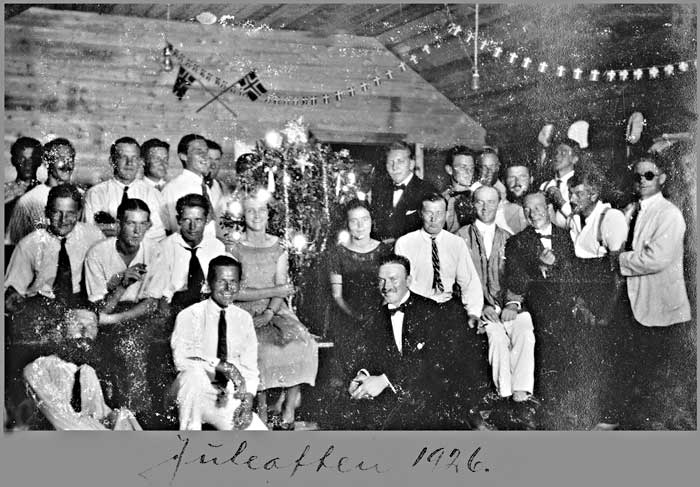
Juleaften (Christmas Eve) 1926. Everyone is in a cheerful mood when Christmas Eve is celebrated in the factory. Isabela has just arrived with parcels, mail and provisions, including tobacco and goodies. Photo courtesy Karen Østmoen.
On Christmas Eve, which is when Norwegians have their main celebration, Skaraas writes:
“Christmas Eve, the 24th, the sloop arrived. We received a lot of provisions and mail. I got six letters and a bundle of newspapers. The boat left immediately in order to arrive at Floreana in the evening.
“We had a really good Norwegian Christmas especially as we now had something to drink and smoke. Neither fir nor pine trees grow here, but we located a nice tree resembling a birch. This was trimmed with decorations that nearly everyone had brought with them, and so we had a beautiful Christmas tree and got into a fine Christmas mood.”
But not only good news came with the mailbag on Isabela.
They also learn that the sale of Ulva is completed and although she is not to be taken over officially by the Ecuadorian Navy before January 10th, 80,000 sucres have already been paid and nearly all of it sent to Norway. They get news relating how the consul operating as agent had collaborated with Trygve Hyenæs in Tønsberg, who is supposed to have asked for kr. 60,000 to cover his own expenses and salary! In short, there was no money left for themselves! How now to obtain provisions, tobacco, gasoline and kerosene, which have to be purchased on the continent?
The shipment of canned goods which went with Ulva and Isabela in October, was quickly sold by Reidar Østern through the agent Eduardo Foppiano. The quality was good and included 16 cases of 96 cans each. But by the time storage expenses and all the agents and middlemen, including Ulva's own representative, were paid, once again there is no money left!
Therefore, during the period between Christmas and New Year's Eve there was a lynching mood in the colony on ”Ulveneset“ Wolf's Point. (Ulva, the name of the ship, is similar to the Norwegian word for wolf, “Ulv.” So they named their settlement Ulveneset,” i.e. “Ulva's Point” or Wolf's Point.) But it is impossible to lay blame at such a distance. New representatives have to be sent to Guayaquil, and as fast as possible, sales and administration must be organized by themselves and certainly not in Tønsberg or by some past Ulva-members. They discuss various solutions like liquidation, immediate dissolution of the company, putting the factory up for sale and then buying it back. They debate back and forth, leaders and representatives are chosen and rejected, and a solidarity statement is signed by the 28 shareholders present. The next shipment of canned goods will be sent to the continent in January. It will consist of 180 cases of 96 cans each, and with this cargo they hope to have a financial surplus. Still more cases are in stock, but these are to be used for trading in San Cristóbal.
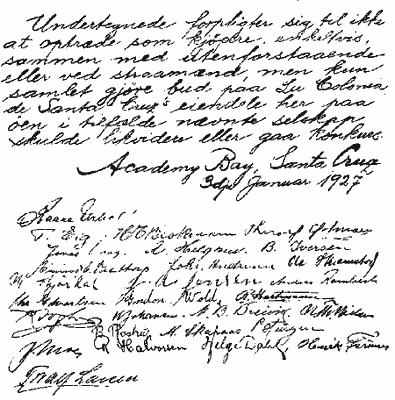
After a lengthy crisis session at the factory around New Year 1927, 28 shareholders signed this statement.
“The undersigned hereby declare that they will not in any way take part in efforts to purchase, individually or though agents, but only collectively, in the event that the property of La Colonia de Santa Cruz is offered for sale through liquidation or bankruptcy.
Academy Bay, Santa Cruz
3rd January 1927
Document courtesy Karen Østmoen.
Meetings continue for several days into the new year. Nevertheless, they plan to celebrate New Year's Eve in proper style. Martin Skaraas writes:
“On the 31st, the sloop from Floreana arrived for a visit. Nearly everyone was aboard. There were Seeberg, Bruun, Waardahl, Johanson, Olsen, Hassel, and a local resident. (Engineer Hassel arrived in Galápagos on his own in 1926. Olsen's bacground is unknown.) We walked around the Christmas tree singing. We were all adults, but at Christmastime grownups are children again. We had plenty of excellent sylte (a traditional dish of spiced pork pieces, compressed into a ham-like shape, and served thinly sliced), hot and cold roast, sauerkraut, rice pudding, liquor, beer and wine. There was a large selection of fruit from our own plantation. Bananas, lemons for juice, pineapple, oranges, all harvested ripe from the plants.
“Thorolf Larsen gave the speech to the guests, and Seeberg gave the reply, as well as a vote of thanks for the meal. After midnight the entertainment started since we did not finish feasting earlier. Bruun directed the entertainment. He was exceptionally good, full of incredible stories, jokes, and a lot of card tricks, but then he is from Bergen. [The Bergen inhabitants are jokingly referred to as slightly crazy and special by other Norwegians. They are known for their wit, good humor and local patriotism; always competing with Oslo!] Then there was Johansen who was also good, so the rest of us had to do something, either sing a song or tell a joke. We did not finish before daybreak…”
In late January, all are waiting for Isabela's return. Tension is high at the mention of canning sales. Besides, they are out of tobacco. Thorolf Østmoen describes one of his co-sufferers who is so desperate for tobacco that he is nicknamed “Ashtray.” He even scrapes the pipes that others have put aside, and chews the ash and tar, as if it was chewing tobacco. This greatly irritates other smokers who find their pipes emptied of valuable remains.
“One day there was a joker who wanted to fool him, so he filled the half-smoked pipe with dry donkey manure and placed it in a readily visible spot. Sure enough, it did not escape the sharp eyes of ‘ashtray,’ and before long the contents were placed behind the upper lip. When he had chewed on it he gave a surprised expression and asked what the heck had been in the pipe he was smoking. When he was told he just quietly said, ‘For sure it does not exactly taste good, but having got it in my mouth I'll definitely chew it to the end!‚ ”
The sale of canned food is improving, and after some months of reasonable income the plan to sell the factory is put aside. But more problems arrive. Isabela is confiscated in Guayaquil, and regular transportation is badly missed in spite of some dissatisfaction with Bruun's freight rates and the fact that the cases often got wet.
The problem is alleviated somewhat when Ulva, now re-named Patria, makes a couple of trips to Santa Cruz. They owe this to their man from Porsgrunn, Herman Hansen Vik. He has remained aboard as first engineer and looks good in his uniform, immaculately white, complete with epaulettes, tassels and a sword. In order to continue to work aboard, he had to be enrolled as an officer in the Ecuadorian Navy!
Meanwhile, Alvarado refuses to let the Manuel J. Cobos call regularly at Santa Cruz. Officially because he says the anchorage is unsafe for a schooner with an unreliable engine, but the Norwegians suspect that he is unwilling to freight their bacalao. He has his own men fishing from the schooner, but they are not as skilled in the salting and drying, resulting in a product of poorer quality. Clearly he does not like the competition.
Then a dry period follows in the highlands. Several newly-sown fields fail. The motorboats are also plagued with problems. Either there are leaks due to teredo (shipworms), or there are engine problems. There are times when none of the boats are running, not even the most reliable one named Hope and Doubt. To procure spare parts for the Fredrikstad Motorfabrik engines proves impossible.
Gradually and rather unexpectedly, lobsters and tortuga are harder to find. Even the amount of groupers declines. The Norwegians call the local groupers torsk (cod), but these species are non-migratory, quite unlike the wandering cod of the North Sea. As they fish out one location the fishermen must move to new ones in order catch more. The same is true for the spiny lobsters.
Rumors, slanderous gossip and back biting, especially regarding their various representatives in Guayaquil, become the final straw for the Santa Cruz colony. It is agreed that they will leave in December, sell everything, and divide the profit among those who stayed and worked throughout. Others will only receive amounts to cover their fares home.
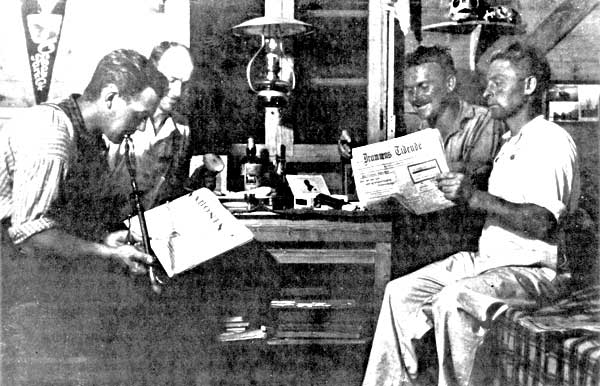
There's nothing like newspapers from home! From left to right are Eivind Erichsen from Halden, M. Th. Nielsen and Thorolf Østmoen from Drammen, and Axel Helgesen from Boda. Photo courtesy Karen Østmoen.
But not all return home.
November 21. Birger Rostrup is soldering cans. This batch of canned food will be among the last as they are running out of sheet metal. A blow torch constructed by Skaraas is used in soldering. Kerosene is connected by a long hose from a pressurized container.
While Rostrup is busy soldering, the coupling between the blow torch and the hose snaps and pressurized kerosine squirts across the floor and all over the man. The liquid on the floor ignites immediately. Without reflection or calling for help, Rostrup starts stamping out the flames with his bare feet. In his fright he forgets about the pail of sand nearby and a large barrel of water just outside the door.
Soon Rostrup himself is on fire. In panic he runs out of the factory like a blazing torch, past the barrel which could have held all of him, rolls around on the ground, but continues to burn. Then he scrambles for the quay and failing to notice the ebb tide, throws himself onto the jagged rocks below. He is badly hurt and is bleeding from several wound when he crawls into the water and finally extinguishes the flames.

He utters not a sound. Andersen and Skaraas are working behind the factory but do not notice Rostrup until he runs for the quay. When they arrive, they help him out of the water and lift him on to the trolley. When they remove what remains of his clothing, large flaps of skin peal off his right leg. There are also burns on his back and left foot. The wounds are cleaned with vegetable oil and they cover him with clean sheets.
Birger Rostrup from Mandel, who died after a tragic accident in the factory. Photo courtesy Karen Rostrup.
The patient assures everyone that he has no pain, asks for a cigarette, lies smoking and smiling, and is embarassed about all the commotion. Then he is gently carried to his own bed in house number four.
Three days later, Skaraas writes in his diary:
“We stood, the lady and I, at the end of the bed and talked to him. He says, Skaraas, when do you think the boat will arrive? I think I will stay here with the others. He stayed, indeed; half an hour later he was dead. He lay with his big eyes looking at us, and died so quietly that we could neither see nor hear it. But the lady said, now he is dead.”
The lady referred to is Anna Horneman. Together with her husband Jacob Horneman, she has made her way to Santa Cruz on her own and now lives in the highlands at Fortuna near Sigvart Tuset.
Birger Rostrup is buried on November 25, 1927.
On December 22, 1927 Patria leaves with nearly everything and everybody on Santa Cruz. Even old Latri the Mexican, and most of the locals who do not want to stay any longer. Only Elias Sanchez wishes to remain in the highlands as a field hand. The factory and machinery necessary for canning production remain, but the rest of the equipment is loaded aboard ship to be sold on the continent. A last big batch of valuable canned food represents a potentially valuable asset for the markets in Guayaquil.
Remaining now in the highlands of Santa Cruz are Anna and Jacob Horneman and Sigvart Tuset. At the beach are Kristian Stampa, Gordon Wold and Gunnar Larssen. These six celebrate a quiet Christmas at the Horneman's. This time the main dish is lobster.
In February 1928, Mrs. Horneman—who is pregnant—leaves for San Cristóbal to live with the Guldberg family while giving birth. When she returns in March, she brings with her a fine baby boy.
Paul Bruun is now skipper on the Manuel J. Cobos, and against the wishes of the owner, he sails to Santa Cruz with mail for the colonists, and takes away fish.
In June, Emil Larsen and Arnulf Greiner come over from San Cristóbal and settle at the beach. They bring along their families as well as a sturdy motorboat made of oak. The Larsens are from Askim, the wife is named Olga and their eight year old daughter, Mary. Eugenie and Arnulf Greiner from Kirkenes have two boys, Per who is three, and Erik born at Campo Noruego, now one year old.
Soon these colonists are like one big family. Tuset cultivates the soil mostly alone, remaining in the highlands two to three weeks at a time. During his free time he frequently visits the Hornemans and receives lessons in both English and Spanish from Jacob. Wold and Stampa each secured fertile land for themselves from the holdings of Rambech and Latris, but they are busy mostly with fishing and capturing lobster and sea turtle. A new source of income is to catch marine iguanas, selling the skin for the manufacture of handbags and shoes.
For a while the belief of the colonists in a Galápagos future is revived. But on October 10 the little community is again stricken with a disaster. Emil Larsen and Gunnar Larssen left the previous day for Tortuga Bay, and have not yet returned. There was a large swell running and they received warnings against the trip, but they left anyway.
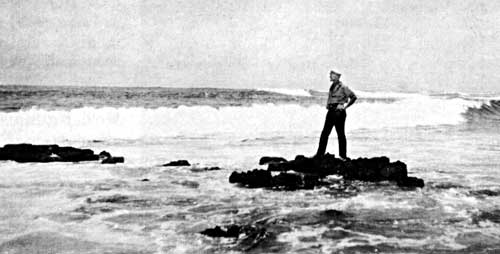
In the morning Arnulf Greiner walks over to the bay and finds his best friend Emil Larsen bruised and lifeless. Dead on the beach around him are several tortuga. Greiner shudders when he looks out to sea and observes occasional huge white rolling breakers far out in the bay.
Bahia Tortuga (Turtle Bay) is situated on the southern coast of Santa Cruz. Time and again, treacherous breakers have caught small boats off guard, both inside and outside the entrance to the Bay. At least nine people are known to have lost their lives here. Photo courtesy Thelma Lea.
Nine days pass before they find the body of Gunnar Larssen on the opposite side of the long bay. There he lies beside the boat's broken bow. It is easy to surmise what must have happened. In the boat laden with their catch, they motored out through the breakers and were swamped, causing the engine to stop, and the boat with its passengers and cargo were hurled against the black lava beds below. The boat and contents were quickly smashed.
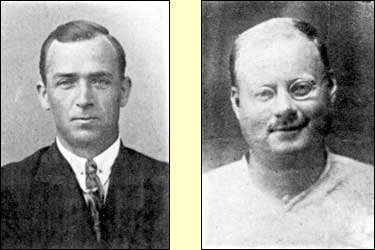
Left: Emil Sigbørn Larsen was originally with Albemarle and had lived on San Cristóbal for a year and a half before he moved to Santa Cruz with his family. He was 31 years old. Photo courtesy Sverre Winther.
Right: Widower Gunnar Larssen was one of the four from Alatga who finally arrive in Galápagos. Photo courtesy Miriam Brekke.
On October 19, 1928, Tuset writes:
“In the afternoon, we were all gathered down at the beach. It was a modest but touching burial. Molvin Knutsen from San Cristóbal read ‘The Lord's Prayer’ at graveside and sprinkled earth on the coffins. Cobos and the Guldbergs sent flowers. On this occasion speeches were superfluous, and we felt bereaved at the loss of the two comrades.
“For those who lost husband and father we lacked words of consolation.”
The Greiner family, with Olga Larsen and daughter Mary, leave for Norway at the first opportunity.
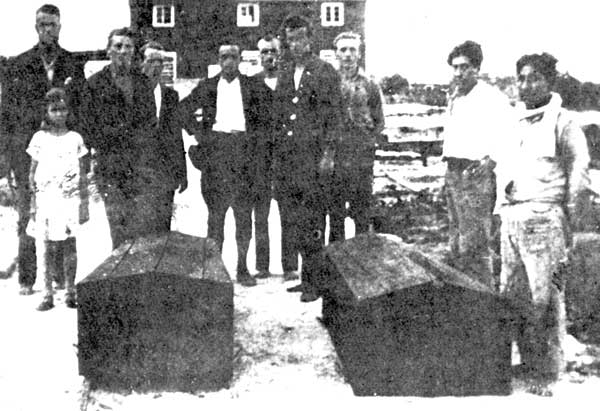
Emil Larsen from Askim (near Oslo) and Gunnar Larssen from Moss were buried on Friday, October 19, beside Birger Rostrup. At left, Emil Larsen's 8-year old daughter Mary and his wife Olga stand behind the coffin. Photo courtesy Miriam Brekke.
Tuset celebrates another quiet Christmas with the others. Now they have food in abundance: roast pork and sauerkraut, eggs and chicken. But what good is this when human presence is needed?
On the second day of Christmas, the gardener Tuset has the honor of baptizing Horneman's baby, whose name becomes Robert August Horneman.
In February 1929, “Grise Johansen” of the Robinson Crusoe expedition finally arrives at Santa Cruz. He is full of courage and keenness, and even has some cash!
Meanwhile, Tuset receives a letter from his Alatga friend, Harald Skramstad, who writes that Colómbia is the country with a future. Tuset sells his lot of land, and part of the new house at Fortuna to Johansen for 120 sucres. And then he waits for the first opportunity to move on.
Anna Horneman also wants to move. She is again pregnant and does not want to risk another painful delivery in the islands. She wants to return home to Lillesand in southern Norway.
Sigvart Tuset concludes his diary of Galápagos:
“Friday June 7. Cobos arrives at Santa Cruz. Horneman with his family and I left Paradise. We left Santa Cruz on exactly the same day and at the same hour, that three years ago Alatga sailed from Tønsberg…”
Back on Santa Cruz only Gordon Wold, Kristian Stampa, Elias Sanchez and the newcomer, “Grise Johansen,” remain.
San Cristóbal
Tired legs are stretched out on an open air porch in Campo Noruego. Content after a long and warm day's work, men and women can enjoy the sunset. From inside one hears domestic sounds, and next door a little one who does not want to sleep is crying. Down in Progreso the crowing of roosters and the barking of a dog can only just be heard—other sounds are carried away with the breeze. Now bend forward, take a sip of coffee, lean back again. The wicker chairs bought in Madeira creak gently with each movement. A basket on the table is filled with tropical fruits. Except for the absence of palms in the foreground, the picture of a South Sea Paradise is perfect. Towards the sunset the sea is shimmering like hammered copper, the Pacific stretching endlessly blue and black to north and south.
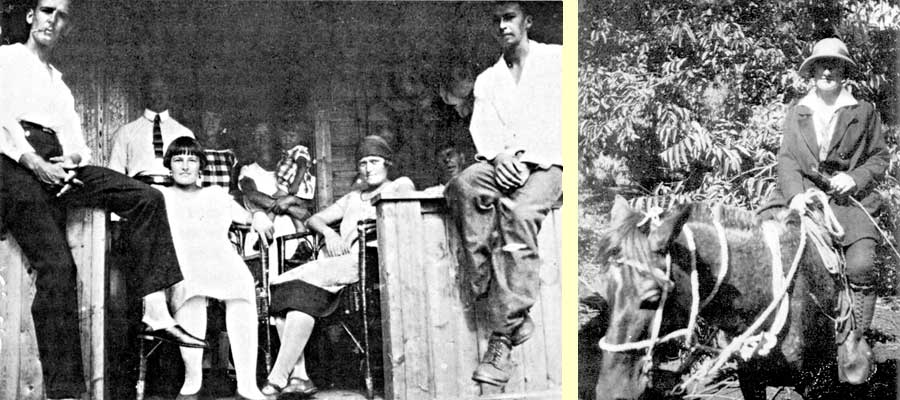
Left: Relaxing on the veranda of Worm-Müller's Campo Noruega.
Right: Ruth Ødegård from Oslo on a ride near Progresso. Photos courtesy Robert Ødegård, Tønsberg.
Coconuts are available and before long the palms should also sprout. And near the beach one may have a cottage and a row boat. On Sundays, a ride on horseback up in the highlands to El Junco to enjoy the view and a picnic lunch, or a trip to Wreck Bay to fish and swim.
There is no lack of excitement either. Here one can hunt cattle or wild boar, or take a shovel and look for buried treasure.
In spite of problems in cultivating potatoes and Norwegian vegetables, things really looked promising for the new colonists on San Cristóbal.
What was it, then, that broke up this colony of enthusiastic farmers and fishermen?
Probably the main reason was that originally few of them were indeed farmers and fishermen. They had insufficient practical experience, especially regarding agriculture, and by and large they were only prepared to cultivate “Norwegian” food.
Other reasons were the minimal advance knowledge about the geography, culture and language. This ignorance served to mystify and make the environment seem more hostile than was justified. Many of the colonists regarded non-whites as inferior, especially the mestizos (anyone of mixed native American blood) who were in the majority. Their disregard was by today's standards clearly racist. Such an attitude built greater barriers than all the barbed wire stretched across Campo Noruego. Spanish language, primitive schools, an inferior public health care service, Catholic religion—not even a church they considered worthy enough for baptizing a child. Everything contributed to making the environment strange and difficult and seemingly unfriendly.
These were problems never considered before, and now they were in the midst of them. After all, was not the original idea to build a Norwegian colony? Nobody had prepared them for living next to Catholics and blacks!
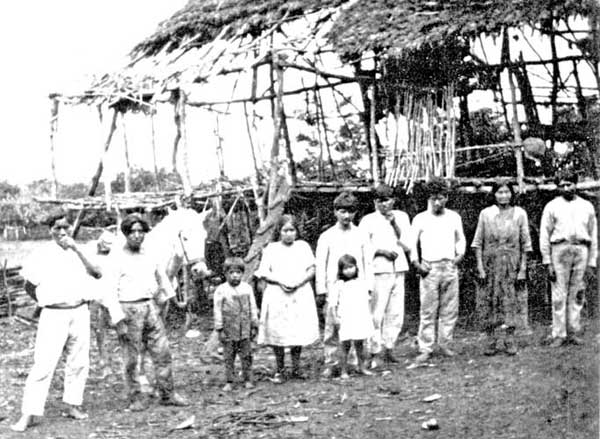
Great class distinction, racial prejudice, language problems and religious barriers made communication between Norwegians and local residents difficult in San Cristóbal. Upon their arrival in Galápagos, the Norwegian colonists were quite unprepared for these problems. Photo courtesy Robert Ødegård, Tønsberg.
There was also the matter of communication with the continent and the outside world. This was better on San Cristóbal than on Floreana and Santa Cruz, but as viewed through Norwegian eyes, it was still miserable.
In April 1927, Patria calls at Wreck Bay, and Arthur Worm-Müller takes this opportunity to send a letter to his brother Jacob in Oslo. The following extract gives us an impression of how the colony is faring:
“Hilda and I went aboard Patria, which is anchored here in Wreck Bay. She has to travel to the continent because of her teeth but will return at the first opportunity for a boat. Despite talk to the contrary, it is possible to have a carefree existence here, but it takes time, and although everything is rather inexpensive, it still costs something to live. For the island's products such as meat, coffee, sugar and a few other items, we have a two-year line of credit, but for everything else we must pay cash.
“So far, I have paid everything in cash but Hilda's trip cost quite a bit. She and Snefrid Guldberg—who will try to get a job as a nurse on the continent—will be guests of the governor. All the other Norwegians who do not think they can make a living here, will travel with them. They each pay 60 sucres. Only about 25 Norwegians will stay, but these are people who will work.
“At the present time we are sending in a large cold storage plant and a tractor; perhaps through their sale I can recover some of the money I lent the expedition. All the way it has been a clear case of cheating. First Randall, then our administrators: Hugo Stray, first mate Andersen, master carpenter Pettersen—who remained on the continent for four months selling the Albemarle for 7000 dollars. They also sold all the ship's equipment separately—and no final statements or refund for the settlers. It appears that the rest of us cannot do anything about it.”
So the sale of Albemarle was another disappointment. As soon as they arrived in Panamá, there was an offer of 10,000 dollars, which was turned down not being high enough. This caused several months of costly delay in Panamá, ending up with a much lower price when the ship was finally sold as a gasoline barge for the port authorities in Buenaventura, Colómbia.
As the case with Floreana, Ulva and Alatga, all the money from the sale was spent in paying off debts and running expenses.
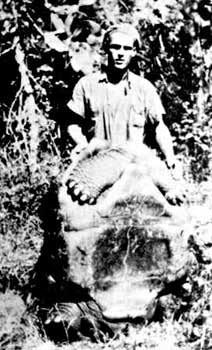
Ewald Formo from Albemarle with a giant tortoise on Isla Santa Cruz. Photo courtesy Robert Ødegård, Tønsberg.
Except for the Guldberg family, Thorleiv and his daughters Snefrid and Karin, Ruth and Alf Ødegård from Oslo were the only ones on San Cristóbal who were successful as farmers. For four years they kept chickens, cultivated corn and bananas, and were due to have their first coffee harvest when they left the island in July 1930.
The reason they succeeded, and even put away some money, was that they farmed the same way as the Ecuadorians. They were shown the correct distance between coffee plants, and planted bananas and corn between each row of coffee so as to provide shade for the tender plants. By these methods they prove that the soil which others ridiculed, indeed, was both fertile and productive.
Corn was excellent food for chickens, and eggs and chickens were good both for sale and barter. Soon they had established a farm of 300-400 birds. Life was good and they were happy.
Why, then, did they leave?
“There were two reasons,” says their son Robert, now living in Tønsberg. “First, problems with the Manuel J. Cobos. It made little difference that the skipper was Norwegian—the ship was still unreliable. The so-called monthly sailings were never on schedule. If the corn did not spoil while ashore waiting for the ship, then it spoiled during the voyage to Guayaquil. The schooner's engine failed all too frequently, and the usual five to six day trip often took some eight to ten, and once even 14 days. When the corn finally arrived, it often was fit only for chicken feed.
“The other problem,” according to Robert, “was myself! I was not yet born but my pending arrival was obvious. My parents were afraid of amebic dysentery, which was continually taking lives. If the malady itself didn't kill the children who became infected, the injections of emetine regularly did. Those were often given by a nurse or paramedic as a doctor was rarely available. And the public health care service did not improve during the four years, in spite of assurances from the authorities. Hence they decided that this was not a place to give birth to their children.”
“But they never regretted the expedition to Galápagos. In later life they often talked about the voyage and their exciting life as frontier farmers.
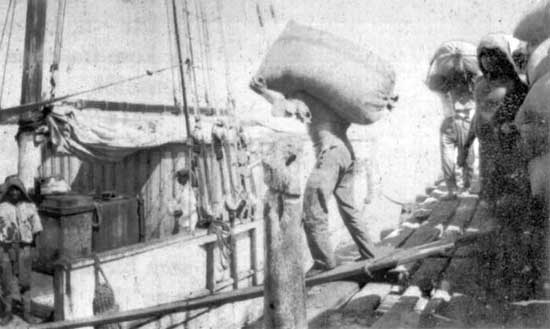
Bacalao, coffee, sugar, yucca flour, corn and cattle were the most important export products on San Cristóbal. Here, the Manuel J. Cobos is loaded with sacks from the trolleys on the long pier at Wreck Bay. Photo courtesy Robert Ødegård, Tønsberg.
The fishing team of Molvin Knutsen also keeps going for a while. It consists of Jens Sæther, who, like Knutsen, is from Ålesund, Trygve Nuggerud from Grorud near Oslo, Emil Larsen from Askim, Ewald Formo from Oslo, Erling Jenssen from Trondheim, and Arnulf Greiner from Kirkenes.
Initially, this group does very well. Lisa (mullet) move in schools in shallow water, feeding on plankton. They are plentiful and good to eat. But the large grouper, which they salt and dry for bacalao, is more and more difficult to catch near Wreck Bay. Fishing has to move farther and farther away while the engines become older and less reliable.
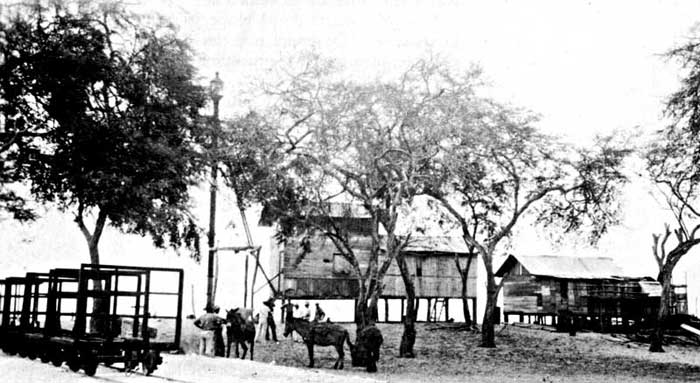
The view looking towards Wreck Bay shows the rails leading to the pier, and what was for a long time the archipelago's only lighthouse. “Johnson from London” lived in the shack next to the light. Photo courtesy of John S. Garth, Los Angeles.
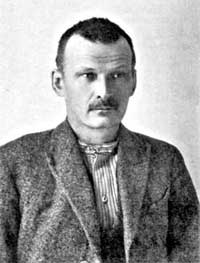
When nearly everbody else is leaving for home, the families of Emil Larsen and Greiner settle on Santa Cruz joining Wold, Stampa and Gunnar Larssen. Then, as related earlier, there is the accident at Bahia Tortuga on Santa Cruz in October 1928. This makes almost all of the original fishing group leave for home. They are scared of this evil ocean, with its unpredictable currents and huge breakers.
The only ones who do not give up yet are Erling Jenssen and Trygve Nuggerud. They stay together at their base on San Cristóbal until autumn 1931. At this point also Jenssen has had enough of the toil and deprivation, but “Nuggen” has found a sweetheart and is thriving. He moves over to Santa Cruz with his Maria.
On San Cristóbal there is only one Norwegian family left, a widower and his two daughters. But Thorleiv Guldberg, tending to his chickens and coffee bushes, is as happy as he thinks he can be anywhere.
Thorleiv Guldberg, photographed shortly before he left Norway on his way to the country where he would find his paradise. Photo courtesy of the Hage family, Lesja, Dovre.
Skipper Bruun
A name that shows up repeatedly in travel books, novels and articles about Galápagos during the years 1926-1931, is that of Paul E. Bruun. [The story about Paul Bruun's last years is based on three main sources: a collection of letters sent home to Norway from Bruun's friend Arthur Worm-Müller, the book Satan came to Eden by Dore Strauch, and the book A Modern Sea Beggar by Temple Utley.]
This flamboyant man from Bergen possessed several ingredients suitable to make him a living legend; former chief flagship captain of a large Norwegian shipping company, suspected of wartime espionage, later a smuggler of hard liquor. Also he had sailed a 39 ft. sloop from Norway to Galápagos—survived hurricanes and rig damage — and raised money to continue the voyage by giving lectures illustrated with slides in Panamá!
Then he conducted a freight service between Guayaquil and Galápagos—900 km each way. Lost the rudder on two trips. On one occasion he made it ashore using a plank as a rudder, the other time with the help of the main boom. He was summoned to court to clarify the ownership of the yacht and won.
In appearance he was like a Nordic viking: tall, fair, and with blue eyes. His facial features revealed his age, but the body was that of a youth, strong and enduring.
And he was the life and soul of any party. He was a talented story-teller and it is said that he could drink anybody under the table, whether the glass was filled with whiskey, cerveza (beer) or guarapo (white rum).
What then was wrong with the man? He was not popular with absolutely everybody.
First of all, in spite of being a former ship's captain, he was strangely and hopelessly unpunctual. Secondly, he was forever getting involved in business ventures, most of which were doomed failures from the start. Some of these had others involved; persons who thus lost their investment.
Bruun also knew how to charge well for his rather unpredictable services, even when the customers were his countrymen. Gordon Wold could not stand the man and recalled that he was a “domineering and unreliable spy.”
Ane Koller from Hamar, who was on the Albemarle Expedition remembers Bruun and Seeberg from the time they were together on Isabela. She recalls both men as friendly and helpful, “but a little too fond of strong drink.”
Bruun's dream was to make it big one way or another. Then he would pay for his children's passage across, let them share his success and finally return to see his family and himself exonerated.
After Bruun has finally won all lawsuits against Seeberg and is awarded property rights for Isabela, the old sloop had deteriorated so badly that it can no longer be used for traffic between the islands. Bruun instead becomes skipper of Manuel J. Cobos, a position he has for two and a half years—until the summer of 1930.
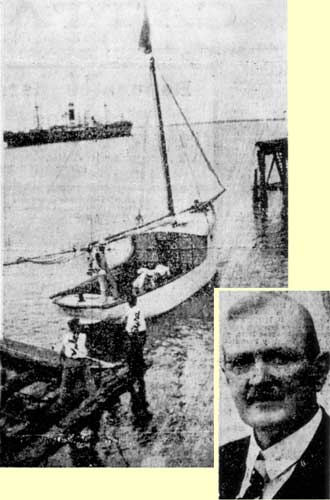
At this time the owner, Rogerio Alvarado, feels the economic pinch of the times. Gradually, and together with Manuel Cobos, Jr., his brother-in-law, he has accumulated an enormous debt to Lorenzo Tous, a Spanish-born businessman on the continent. As security, Tous claims some of Alvarado's property, and among other things, the old schooner. Bruun continues to be captain for the new owner and is very happy when his meager skipper's salary is tripled. Alvarado fights desperately to save his former empire and manages to have his ownership of the schooner restored. He announces that salaries will be rolled back to their original level at which point, Bruun has had enough of worn-out sails, an unreliable engine and decks littered with cow dung.
In Guayaquil Paul Bruun recently made the acquaintance of a young Dane, Knud Arends. Together they have built a 25 ft. fishing boat with a 15 H.P. engine as well as auxilliary sail. Another Dane, Emil “Emilio” Hansen, lends them 8,000 sucres to get the project off the ground. Arends' main responsibility will be to look after business in Guayaquil, while Bruun is responsible for the fishing, with Isla Floreana as his base of operations.
June 27, 1930: The Guayaquil newspaper El Telegrafo reported on the “Old Fox, Captain Bruun,” who had this 25 ft. motor sailor built. It states that the captain is Swedish, but the boat is correctly named Norge! Courtesy of Sigfried Bruun Johannessen, Bergen.
To look after the equipment and stores at Casa Matriz, they bring across Arthur Worm-Müller, who gives up his vice consul job at Guayaquil. He has put some cash aside, and is tired of the city's dirt and disease and is longing to return to Galápagos. But his wife Hilda, for the time being, continues with her English teaching in Guayaquil.
A letter written by Worm-Müller sent home to Norway and dated Floreana, May 15, 1931, describes the new life around Casa Matriz:
“I am now settled on Floreana Island and thriving in every respect. We have lots of chickens so that we have eggs, provided people don't steal them, which they usually do. We also have two fine pigs, one of which we will soon slaughter because we have very little fresh water. The other pig will probably give birth to piglets one of these days. We are looking after a big beautiful dog named Theresa. In an enclosure we have 12 small and one very large tortoise; it requires two men to lift her. Every day they are fed cactus pads, the only food they require. We have them for sale when American yachts come by. I have a small one named ‘England’ because it is very greedy…
“Each week there are people in the highlands who shoot a bull or a cow. They are very plentiful. Also wild pigs, but they are so lean, maybe because they eat lots of lemons which are found in heaps. There is also an abundance of the most delicious oranges and avacados-pears; we are not so badly off, what do you think? Because it has been such a long time since a ship has called, we are now short on coffee, tea, butter and spices, and soon we'll be out of sugar and rice, and that is serious because if the locals do not get rice they consider themselves to be unfed. But it will all work out somehow. We expect a ship to arrive one of these days, but down here nothing but death is certain.
“Since Bruun is away fishing a lot of the time, I am mostly alone, and have become accustomed to it. I have some books, and occasionally I receive some extremely old Norwegian newspapers, which I study thoroughly.”
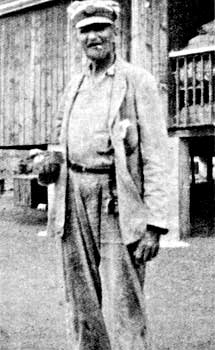
Temple Utley, a 35 year old medical doctor from Yorkshire, England, is circumnavigating the world aboard his sailboat Inyala. With his crew of two he has anchored in Post Office Bay, Floreana on May 16 where he meets Paul Bruun who just returned with Norge after a fishing trip. The two became friends immediately, and Bruun invites the Englishman for the May 17th celebration (Norwegian National Day) at Casa Matriz—and to become a partner in his business affairs. Inyala can be used for both freighting salt from the salt lake on Santiago and the finished bacalao from Floreana to Guayaquil.
Utley immediately takes to Bruun. He is tempted by the offer and considers discontinuing his circumnavigation of the world, at least for one year—and possibly even settling permanently in Galápagos.
First he will help Bruun with the transportation of salt, and then after a couple of weeks he will make a final decision. They leave for James Bay on Santiago with Norge and Inyala and a total crew of eight men.
Paul Bruun in working clothes outside Casa Matriz, Floreana. Photo from a ca. 1956 article in Vi Menn.
Utley has never experienced such hard work, and according to the Englishman, Bruun works just as hard as the much younger native American Indians. Because he never raises his voice or scorns them, the popular boss gets the men to work until they nearly collapse.
The volcano with its crater lake lies three kilometers from shore. From its rim there is a 200 m (650 ft.) steep drop down to the salt lake. A spiral path leads down the inner slope of the crater, and only climbing down to begin working is hard enough.
The salt is dug up with shovels in the middle of the lake, heaped on rafts, and floated to shore. There the salt is put into one quintal (45 kilos or 100 lb.) sacs, loaded on to trolleys, pulled almost straight up to the rim of the crater, and rolled down the three kilometers to the shore, where they are transported in a dinghy to the Norge and Inyala.
For a few hours in the middle of the day the heat is unbearable, especially down at the crater lake, but otherwise they work from sunrise until the last rays of light disappear at about half past six in the evening.
It is exhausting work but with prospects of a good profit. The salt is needed to prepare bacalao. The three-week expedition to Santiago yields approximately 10,000 kg (10 tons) of salt, which is stored in Casa Matriz.
The next letter from Worm-Müller is dated June 30:
“The British yacht Inyala with Dr. Utley as skipper, has been anchored here since May 16. The doctor has made a trip with Bruun to Chatham (San Cristóbal) as he needed coffee and sugar, items that we also need. They also brought the governor, because Bruun was to sail on to Albemarle (Isabela) to fish. They left on the 20th and have not yet returned. With Bruun is a three-man crew, as well as the governor, Dr. Utley and a German named Schmidt who lives here on the island.
“Provisions are now in short supply, we have only coffee, sugar and bacalao. On several occasions four of my men have been up to the highlands to hunt but returned empty handed. They say the mist up there makes it difficult to see anything.
“Yesterday, Sunday, I sent the yacht's cook up again, hoping they would bring down something, because a diet of bacalao becomes tedious in the long run.
“In July we surely can expect the government's boat here because the garrison on Chatham Island is changed each July and December. At the present time I have a credit of 800 sucres. There are 129 quintals (approx. 6 tons) of fish now ready for shipment. Even with a rather low price it should be worth about 3,000 sucres.
“When Bruun left, he took the last available fuel with him, enough for 14 to 16 hours. It should be of little consequence, however, since at this season we always have wind. We have an old lifeboat here but it is leaking badly and its motor is out of order.”
The next day, July 1, the letter continues:
”Yesterday evening at 10 o'clock, the ship Cobos arrived here from Guayaquil. I received lots of mail and newspapers.
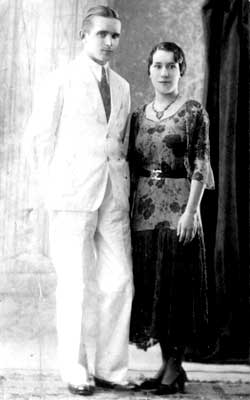
“Arends came along and wants to stay a while. He tells us about the situation in Ecuador; it has never been more miserable, nothing but bankruptcies. The Bank of Ecuador will close and several other closings are expected.
“The price of our fish is now down to 12-15 [per quintal], therefore Arends wants to try to can the fish like those on the Norwegian ships. Naturally, it is a question of money, but he thinks he can manage. Since the lifeboat's motor has always been unreliable, he brought with him a Swedish outboard engine which costs 1000 kroner. His credit must be fairly good but the shop where he bought the big engine insists on down-payments, which is understandable. (This must refer to Norge's marine engine.)
“He, Arends, brought with him rice, lentils, onions, butter and some cheese, so there is something to eat again. Believe me, we live frugally many a time.
The Dane, Knut Arends, came to Ecuador as a young man. He established a close friendship with Bruun and became his partner in 1930. Arends—portrayed here with his fiancée Mercey—sold bacalao which Bruun caught using the Norge. Photo courtesy of Arne Falk-Rønne, Denmark.
“Captain Bruun has not yet returned so Arends asked the Cobos to look out for him, in case he needs help.
“Bruun has mixed his heavy duty motor oil with a lot of gasoline so I hope nothing has happened. The large motorboat is the company's biggest asset; if that fails, everything will collapse.”
Worm-Müller signs the letter; but at midnight he sits down and writes a postcript. He is much relieved because the schooner has just called with good news:
“Bruun rides at anchor with his boat Norge in a port called San Pedro on the island of Isabela. He had run out of fuel. Because of contrary winds he could not sail to Villamil. M/S Cobos is bringing him fuel; he will be here within a few hours.”
Worm-Müller is unaware that he has seen his friend for the last time.
On Friday June 20, as Worm-Müller writes in his letter, Norge left Floreana for Port Villamil on Isabela with Bruun, Utley, governor Ribadeneira and the German Schmidt on board. At Port Villamil they were treated like royalty by Señor Gil. They buy a great deal of merchandise, including live tortoise, and between one and two thousand cigars each!
After a few days in Port Villamil, governor Ribadeneira has carried out his half-yearly inspection of the island. It consists mainly of wandering among the poor-looking houses, dressed in his splendid uniform. Then they are ready to sail home. They have to sail indeed because there is only sufficient fuel for four or five hours of motoring.
As it has done so many times before, History repeats itself. The wind fails and the current reigns supreme. Near the coast of Isabela it approaches 2.5 knots. Norge is beamy with only a three-foot draft and beats miserably against the wind. Mercilessly they drift westward.
Soon it is impossible to return to Villamil. The only way out is to use the last of the diesel fuel to enter San Pedro, a small lagoon with a shallow entrance, west of Cabo Rosa—still on Isabela. If the engine fails at the entrance, they are lost. Surf breaks unceasingly on both sides.
They barely succeed. The motor coughs and stops just as the anchor is lowered in the lagoon. There is a swell running, but for the moment they are safe.
The next day Bruun takes three men and rows the small boat Sigfried to Port Villamil. It is dangerous and hard work but they accomplish the 20 nautical miles in 20 hours. Cobos has not yet arrived. Bruun erects a rig for the boat and takes two volunteers with him to try to row to Floreana, where he is sure Cobos will arrive at any time. The matter is urgent because if the wind increases, Norge is unsafe in San Pedro.
For three days and nights Bruun and the two men keep rowing before they have to give up. They return to Villamil, completely exhausted.
At the same time governor Ribadeneira arrives at Villamil—in miserable condition. He doubted that Bruun would succeed in rowing and decided to walk on shore. He managed the 37 waterless kilometers (23 miles) from San Pedro to Port Villamil in four days and nights, but nearly paid for it with his life.
Finally, in the evening, the Manuel J. Cobos does arrive. Alvarado, owner and now also captain, has been to Floreana where he put Arends ashore, and was asked by Worm-Müller to look out for Norge, and at the same time pick up the governor.
The next morning, Wednesday July 1, the schooner carries Bruun, four other men and the Sigfried almost to the entrance of San Pedro where Norge had sought shelter. The sea is rough and Alvarado dares not go too near the coast but offers to wait until the others are safe.
Bruun snorts at the proposal and says he bets that with his faster Norge he will return to Post Office Bay long before Alvarado's ancient pirate ship!
So, while Bruun rows with his load of four men and four cans of diesel oil in the 12 ft long Sigfried, Manuel J. Cobos sets a course southeast toward Floreana.
On this day the contrary current is strong and Cobos does not arrive at Floreana until after sunset. Arends and Worm-Müller received the message that Norge is safe and that Bruun is just behind—but that old Viking has just lost a bet…
Aboard Norge, Temple Utley sits in the cabin relaxing with a cigar, when suddenly he hears “Capitano! Capitano!” It is one of the crew, calling and pointing out to sea. Utley looks out and catches sight of a small rowboat, apparently filled with people. At the same moment, a giant wave rises behind the boat, breaks and hides everything in white surf.
But when the sea calms down, everybody is still aboard with one man struggling behind the oars. Almost immediately another huge breaker covers the boat, and this time Utley sees how boat, oars and people are thrown about in complete confusion. When the sea once again is calmer, there is only one man left aboard.
It is Bruun. He is kneeling in the stern and tries to row with one oar. Two men attempt to swim to shore, two others are climbing aboard the dinghy. Utley searches frantically for a rope that he could swim out to them. The only suitable rope is securing Norge ashore since one of the two anchor chains broke the previous day.
The rope has become entangled on the bottom and it takes a couple of minutes to loosen it. With the rope tied around his waste, Utley wades out between the rocks preparing to swim, but several great waves arrive in rapid succession, first throwing Bruun into the water and then knocking himself off his feet. When he regains his footing he sees that the dinghy has drifted to the opposite side of the lagoon.
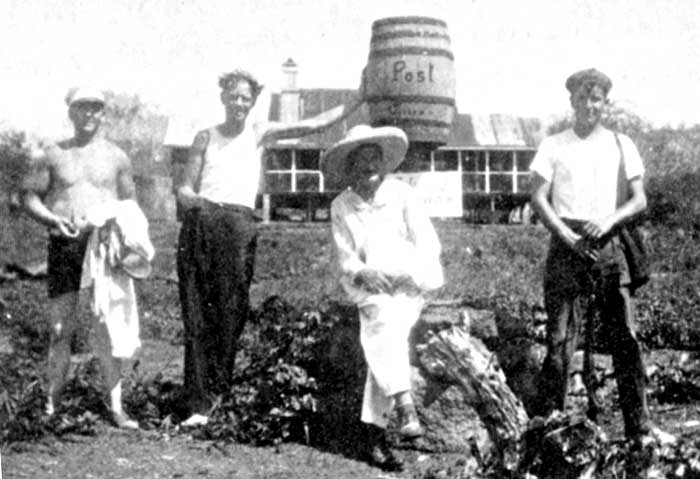
The last known photo of Bruun, taken in May 1931 in front of the mail barrel in Post Office Bay, together with the crew of a visiting ship. Casa Matriz is seen in the background. Photo courtesy of Jacob Worm-Müller, Oslo.
Utley scrambles ashore again and starts running around the lagoon. He sees with terror that the dinghy is being smashed against the rocky shore. Finally he reaches it and finds two men badly bruised but not seriously injured. There is no sign of Bruun. When he questions the two, they only shake their heads.
Utley searches desperately. Minutes pass and with his heart pounding he tries to estimate for how long he can still hope to save Bruun—if the sharks have not already snatched him. Finally he sees a shape between stones awash in the lagoon. He swims out and finds his friend—lifeless.
Next day he writes:
“In the morning we buried him. We dug a hole between lava blocks, laid him down and built a large cairn of rocks above. It would have been more appropriate to cremate the old viking on a tall funeral pyre.
“I doubt that I have ever been so depressed. While we were busy with the grave, I experienced the same sensation as when my father died: the terrible feeling of wanting to cry but being unable to do so. During these weeks I learned to love this man, I was ready to go with him wherever it might be. There are not many like him.”
On the grave they erect a cross made of planks taken from the dinghy Sigfried, named after his youngest daughter back in Norway. On the cross is the inscription:
“Captain Paul Bruun, July 1st—1931.”
With the Sigfried disaster, the diesel fuel is also lost and there is little food and water for the number of people gathered in San Pedro. During the next few days Utley and the men make a pair of oars for Norge, and when the swell calms down they row her out of the lagoon. But it proves impossible to work the boat towards Villamil or Floreana, since both current and wind prove to be straight against them. They drift still further to the west. Finally they manage to row Norge into another small lagoon near Iguana Cove, not far from the place where the wreck of Alexandra rests deep in the water. In the bay they find a narrow channel where the boat can be made fast on three sides. Then they start on a desperate hike over the volcanic mountains towards the village of San Tomás, 50 km (31 miles) away, as the crow flies.
Meanwhile on Floreana, Arends and Worm-Müller are now very worried and fear the worst. Arends takes some men with him, attaches the outboard engine on the old leaking lifeboat and leaves for San Pedro where Alvarado has reported last seeing Norge. They search both at Villamil and San Pedro without finding the missing boat still moored just past the southern point of Isabela.
While Arends takes a short nap, the others are not attentive and motor too close to the shallows. A freak breaker capsizes the boat which is smashed against the rocks.
None of the men are seriously hurt, and they also rescue the motor. Soon it is their turn to start marching. They still do not detect Norge, only a few kilometers further west.
After three days of suffering, Arends and Utley's cook stumble by chance upon the grave of Bruun. Arends is overwhelmed with grief. The old captain was not only his partner, but a friend and father figure. He lies across the black rocks and cries like a small child. One of his legs is cut and inflamed, the discovery of the grave leaves him broken hearted. Now he believes that Norge is also lost. He refuses to continue. The cook carries on alone and arrives at Port Villamil on the sixth day.
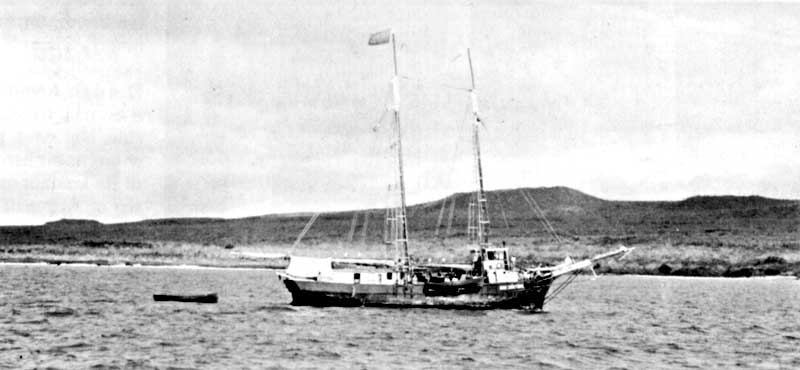
Bruun was captain of the Manuel J. Cobos for about 18 months before he started trading with the Norge. The island community was dependent on the old schooner to obtain provisions from the continent. Delays and fuel shortages proved fatal for Bruun, her former skipper. When this photo was taken in 1934, the schooner had been re-named San Cristóbal. Photo courtesy of John Garth, Los Angeles.
Señor Gil sends out an expedition which picks up Arends and the remaining men, one after another. Almost unbelievably, they all survive. Then one of Utley's group reaches San Tomás in the highlands of Isabela—another expedition to the rescue.
Utley barely saves his life, but one of the other men in his party—the cook from Casa Matriz—is never found.
Meanwhile, San Cristóbal-Norwegians Erling Jenssen and Trygve Nuggerud have been to Floreana where Worm-Müller is very worried and ignorant of the dramatic events on Isabela.
The two promise to join in the search and leave for Port Villamil where they arrive in the middle of the rescue work. They summon additional help, including Kristian Stampa and Gordon Wold from Santa Cruz as well as one more boat.
Utley has recovered sufficiently to go with the four Norwegians to the tiny cove where Norge is moored. There they find that two of the ropes have parted with the result that the boat developed a leak in the hull and sank—but not too deep; the foredeck sticks out of the water. The door down to the lounge has sprung open, and all that can float has disappeared, including the governor's dress uniform.
Cigars are scattered along the shore as far as the eye can see.
They report back to Arends, who is too sick to take part in raising Norge. He begs Utley and the Norwegians to do the job.
Inyala must be brought in from Post Office Bay, and empty gasoline drums, tackle and pulley blocks collected. Before they get started it is August 1931. With the rescue well underway, Utley decides to say goodbye to his new friends and to continue sailing westward.
Finally, the four Norwegians succeed in rescuing Norge after almost losing their own boat during the operation.
The Dane Arends starts fishing again, but without Bruun the enterprise no longer flourishes. Before the end of the year, he gives up and leaves the Norge to his main creditor and countryman “Emilio” Hansen and moves to San Cristóbal.
Worm-Müller tries unsuccessfully to tempt some of the Norwegians to move over to Floreana. Instead he moves to Santa Cruz. Hilda also comes over from Guayaquil and they settle in the upstairs of the factory.
Casa Matriz is again empty.
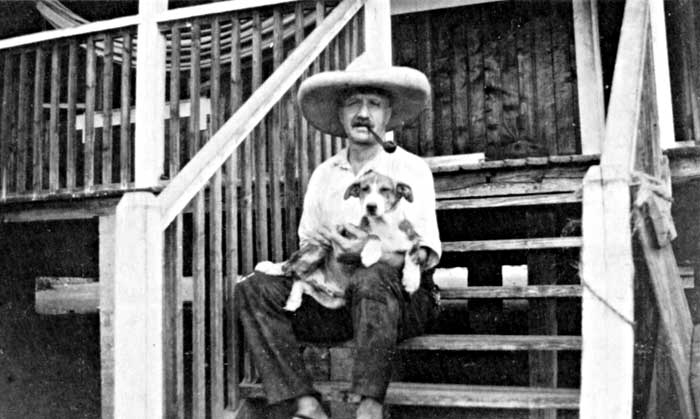
Arthur Worm-Müller with his dog Theresa on the steps of Casa Matriz in 1931. He gave up his vice-consul job in Guayaquil to join Bruun and Arends as a partner. After Bruun's death he moved to Isla Santa Cruz. Photo courtesy of Jacob Worm-Müller, Oslo.
Dr. Ritter, the Baroness, and the Tragedy of Trygve Nuggerud
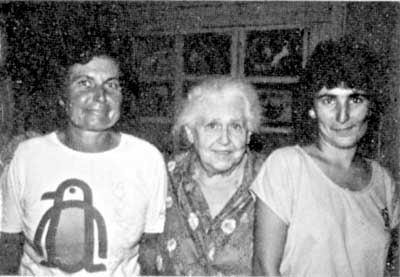 Three generations of Wittmers still live on Floreana. Margret, 81 years old (in 1985), with her daughter Ingeborg Floreanita and grand-daughter Trudi Beatrix Maria.
Three generations of Wittmers still live on Floreana. Margret, 81 years old (in 1985), with her daughter Ingeborg Floreanita and grand-daughter Trudi Beatrix Maria.
Floreana—the island with the flower name—has not been overpopulated up to now and is not likely to ever become so.
In 1985 about 80 people live on the island, half of them civilians, the other half military personnel. Most of the inhabitants live at Black Beach Road on the west coast, five kilometers south of Post Office Bay. Here the local government has installed a generator, supplying electricity for a few hours each evening, and at the military station there is a radio transmitter with a theoretical range to the continent. But spare parts are still a problem, just as it was 60 years earlier when Ludvig Næss tried numerous tricks to make his transmitter operational in Post Office Bay.
The island's grand old lady and the best known personality in the archipelago, Margret Wittmer, lives here. On the Ecuadorian mainland she is known as Doña Margarita. At Black Beach she lives in her “Pension Wittmer.” She is blue-eyed, white-haired and slightly hard of hearing, but in spite of her 81 years still serves as the island's postmistress and sole hotel proprietor. [Mrs. Witmer died at the age of 96 on March 21, 2000.]
In her small boarding house she serves scientists, journalists, sailors, and more commonly, tourists which arrive on a near regular basis. But one should make reservations a week in advance, because Mrs. Wittmer likes to be able to serve freshly caught lisa (mullet) or langosta (lobster), and she wants her guests to be uncrowded at her dinner table.
Next to governmental assistance from the continent, tourism today provides Galápagos residents with their main source of income. On the other islands it is the peculiar fauna and flora that is attractive. But no other Galápagos island has suffered so much destruction of the environment, either directly or indirectly by people, as Floreana. Over the past 200 years, domestic animals have gone wild, and with imported mice and rats, introduced plants and insects have caused irreparable harm to the island's biota. Giant tortoises have been extinct since about 1830, and the once so numerous land iguanas have also disappeared.
This deplorable situation nothwithstanding, Floreana still attracts tourists, primarily because of Doña Margarita herself and the book she has written. It was first published in Germany in 1959 as Postlagernd Floreana, and later translated into several languages, including English (Floreana Adventure) and Norwegian (Det Siste Paradis—“The Last Paradise.”)
Together with her husband Heinz and 12 year old stepson Harry, two dogs and a load of personal belongings, Margret Wittmer arrived on Floreana in August of 1932. The Wittmer family wanted to get away from painful war memories and generally hard times—like so many others—and wanted to make a new career for themselves as farmers in Galápagos. And they succeeded better than most, even though Heinz originally was a secretary to the then Lord Mayor of Cologne, Konrad Adenauer.
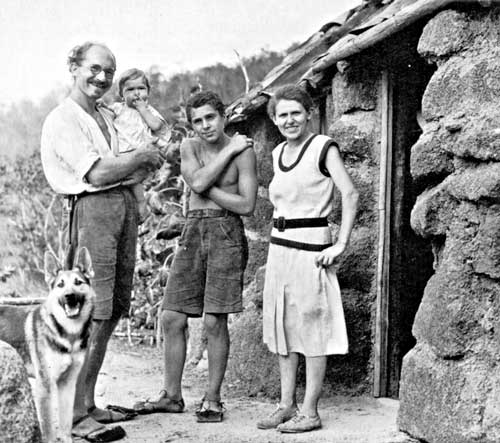
Mrs. Wittmer says that they chose to settle on Floreana because of Dr. Ritter's romantic articles about the island.
Heinz, Harry and Margret Wittmer together with baby Rolf and German shepherd “Lump.” The family came from Cologne, Germany in 1932. Rolf was born in January, 1933, when the family were still living in the pirates' cave. At the time of the photograph they had moved into the house by the spring that Heinz built, almost 100 meters from the cave. Margret and Rolf continue to live on the island, but at Black Beach. Photo courtesy of the Allan Hancock Foundation, Los Angeles.
It is a quiet evening in April 1985. We have had a long and strenous day, hiking around the island, searching for memories of the Floreana expedition. Now we are relaxing in Mrs. Wittmer's sitting room, sipping “Vino Casa Wittmer”—homemade orange liqueur. We have just been served lobster and chicken by Doña Margarita's daughter Ingeborg Floreanita and granddaughter Trudi.
“This Ritter was a strange fellow,” admits Mrs. Wittmer—but she is really not very interested in talking about the eccentric doctor. Though they were neighbors for two years, they never developed a close friendship.
It was in September 1929 that the couple Dore Strauch Koerwin and Friedrich Ritter arrived in Galápagos. Ritter was highly intelligent, well read and qualified both as a dentist and a medical practitioner. But above all he had a burning interest in philosophy. He was a disciple of Nietsche and Lao-Tse. Still, his favorite book was Daniel Defoe's Robinson Crusoe!
To illustrate his philosophy Ritter drew complicated forms filled with abstract ideas. These figures were impossible to comprehend by the uninitiated, but the philosophical message was easily explained. To find one's Eden one has to escape from the hustle and bustle. Preferably to an uninhabited island, and in any case, to live as a vegetarian on the fruits of the soil and in harmony with Nature.
Ritter wanted to establish his Eden in Galápagos.
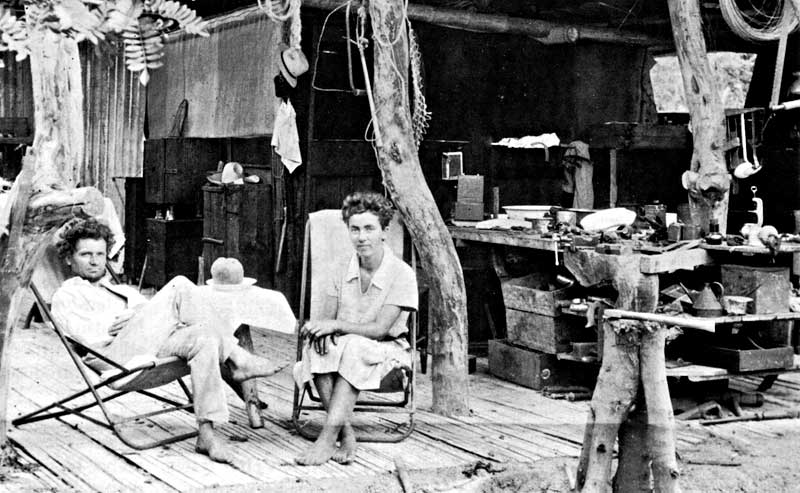
Friedrich Ritter and Dore Strauch in their home “Friedo”—also called “Eden.” Ritter was an eccentric doctor, dentist, and amateur philosopher from Berlin. The two came to Floreana in 1929. Photo courtesy of the Allan Hancock Foundation, Los Angeles.
Dore Koerwin suffered from multiple sclerosis and was originally a patient of Dr. Ritter. She became fascinated by this short-statured but strong and intense man, and was convinced that he was a genius of a caliber to the world's great philosophers. She was willing to follow this man wherever he decided to go.
The two ended their respective childless, unhappy marriages, and in greatest secrecy, to avoid scandal, started assembling the necessary equipment for an independent existence on a desolate island.
As a precaution to prevent tooth problems, Ritter had all his teeth extracted before he left Germany, and he had a set of stainless steel dentures made. Later, on Floreana, Dore also had teeth removed by Dr. Edwin Palmer during a visit by one of Allan Hancock's expeditions. It is said that she sometimes borrowed Ritter's teeth when they had visitors.§
§ See the doctor's Medicine Man for his description of the operation, and Hakon Mielche's Let's See if the World is Round for his observation about Galápagos teeth sharing.
In autumn of 1929 they arrive in Guayaquil where they board the Manuel J. Cobos for Floreana. Despite “Capitano” Bruun's suggestion that they change their plans and join him in a partnership, they go ashore in Post Office Bay with their cases, trunks and sheets of roofing iron. With the help of Hugo, a 14 year old Native American Indian, and a horse which soon collapses from the exertion, they get their equipment transported up to the highlands. Here they settle near Wolf's [sic, Wittmer's] Spring on one of the former properties of the Irishman, Patrick Watkins. They baptize the place “Friedo” after their first names, but they also refer to it as “Eden.”
When Paul Bruun returns with Cobos a couple of weeks later, he has to admit that the two Germans have no lack of determination to succeed! Soon, seeds are planted and germinating, and the philosopher can report his successes at Eden in articles to the outside world
Friedo is not an ordinary house. It has walls on only two sides, and the large acacia trees are allowed to remain undisturbed in the middle of the house. Soon, seeds are in the ground and germinating—the philosopher Ritter can report to the outside world about his successes at his Eden.
“And the presence of Dr. Ritter was the main reason that Heinz and I chose Floreana three years later,” says Margret Wittmer. “ I was pregnant for the first time, and knowing there was a German doctor on the island gave me a sense of security in case of complications.”
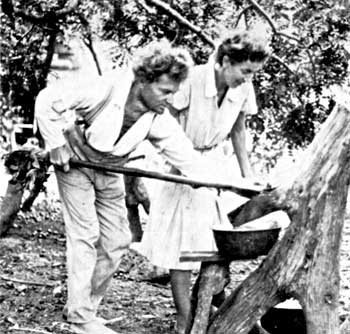
Initially, the Wittmer family lived in the same pirate cave that the Norwegians Bang and Aschehoug had inhabited ten years earlier, while nearby, Heinz built what would become their first proper home. But they were still living in the cave when Margret gave birth to her first child (Rolf, 1933-2011). It was a slow and complicated delivery, and it was indeed thanks to Dr. Ritter that all went well. But otherwise the relationship between the practical, down-to-earth family and the intellectual philosopher and his devoted girl-friend was strained. This she recalls as we are comfortably seated and sipping her home-made orange wine.
Dr. Ritter and Dore lived mostly as vegetarians. They liked to show visitors how they managed with what they cultivated themselves. Here they demonstrate their sugar cane press. Photo courtesy of John S. Garth, Los Angeles.
Earlier in the day we had searched for remains of Casa Matriz and the Norwegian colony in Post Office Bay. In 1985 there is very little remaining, only some walls and pillars and some large, rivetted steel cauldrens intended for melting whale blubber and storing water.
Those who have time and patience, however, can find a variety of items hidden in the brush. After a half-hour search we found a half cup from the Egersund Fine Porcelain factory and several bits of pottery with a well-known straw pattern from the Porsgrunn China factory. Some Swedish buckshot cartridge cases and pieces of ceramic light fixtures probably also came with the Norwegians. But barely a trace of planking could be found.
Mrs. Wittmer explains that the house was still there when she arrived in 1932. Most of the time it was empty except when Norwegians arrived from Santa Cruz to fish or hunt and stay overnight at Casa Matriz. Gradually, all that was unattached disappeared; some of the corrugated iron roofing was also removed. What loose items remained were finally taken away when the military needed materials for erecting a camp on Isabela in the mid-1930s. Later there were no new attempts to settle in Post Office Bay, but the famous mail barrel still stands.
“Where is the Spring?”
From her first year on the island, Mrs. Wittmer recalls the Norwegians who came to Floreana from Santa Cruz to hunt for wild cattle. In particular she remembers Kristian Stampa and Trygve Nuggerud. And she can never forget the tragedy which befell Nuggerud.
But in order to relate the story about what happened to the former forester from Nuggerud farm in Grorud near Oslo, we also have to introduce a baroness and two lovers.
Two months after the arrival of the Wittmer family, an odd trio came to visit the pirate cave. On foot were two Germans, Robert Phillipson and Rudolf Lorenz, and riding on a donkey with an expression on her face appropriate for an empress, the so-called Baroness Eloise von Wagner-Bosquet. The first words spoken were said by the baroness:
“Where is the spring?”
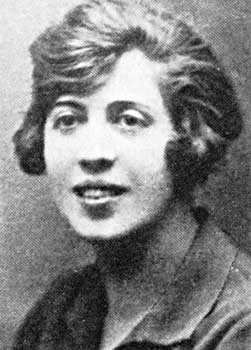
Mrs. Wittmer was quite speechless and could only point in the direction of the little spring. The group continued towards a basin in the ground into which the Wittmer family channelled the water from the small spring. The thin, blond Lorenz helped the baroness off the donkey, took her shoes off, and submissively washed her feet. “In my drinking water!” Mrs. Wittmer later writes in her book.
Baroness Eloise von Wagner-Bosquet in her youth. Photo courtesy of John Treherne, from his book The Galápagos Affair.
The actual background of the baroness is uncertain and her own version is likely to be unreliable. It is doubtful that she was a legitimate baroness. However, it is certain that she lived in France shortly before coming to Floreana and that Rudolf Lorenz was her lover. Lorenz owned a shop in Paris. He was 15-20 years younger than the baroness but, nevertheless, idolized her. Then the Jewish Phillipson arrived on the scene. Later he is introduced as her husband but it is doubtful that they were ever legally married. In Paris, she and her two men read about Dr. Ritter on Floreana. About the same time they became acquainted with an Ecuadorian named Valdivieso, and together they conjured the plan of building a luxury hotel for wealthy Americans on the island.
Lorenz sold his shop, and for the money he received they started to fill more crates than Ritters' and Wittmers' combined. And so, the voyage to the Land of Promise was about to begin. With Valdivieso, who knew the language and locality, they procured 35 tons of cement and other construction materials in Guayaquil, enough animals, including two calves and two donkeys, seeds and cuttings to start farming. All was unloaded in Post Office Bay.
For the time being, the baroness occupied Casa Matriz with her men, her silk shawls, her cosmetics, mattresses and a couple of couches. Most fantastic of all, however, is her proclamation that she was now empress of Floreana. A few months later she moderated her behavior somewhat, but was still making life quite uncomfortable for the Ritter couple and the Wittmers. She censored their mail, confiscated provisions and gifts, and spread false rumors about them among visitors and in articles she had published in Ecuador and Europe.
Soon the story about the “Empress of Floreana,” her entourage and the other Floreana residents circulated around the world.
Some weeks after their arrival on Floreana, the baroness' two men, with the help of local workers, started building the planned hotel and brought it to a stage such that her highness could move in. The site they had chosen was between the orange trees, a couple of hundred meters below the Wittmer property, and on the same site as was “Camp Morten” some years earlier.
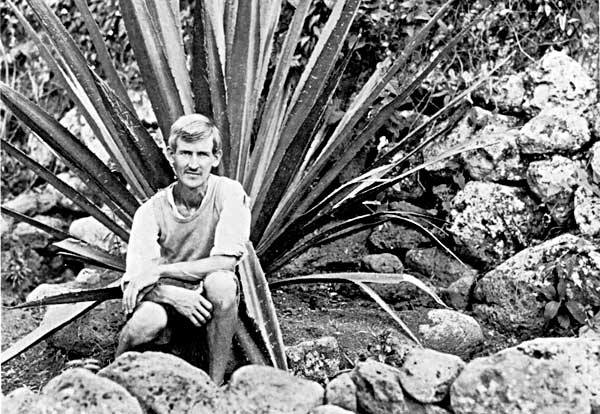
Rudolf Lorenz was German, but owned a boutique in Paris when he first met the baroness. Photo courtesy of the Allan Hancock Foundation, Los Angeles.
At this time Kristian Stampa and two of his men come across for hunting. They stay overnight at Casa Matriz between the baroness' belongings, and next day walk up into the hills where they shoot two calves. The animals are skinned before some of the meat is carried to the beach to be dried and salted. There Stampa is stopped by a furious baroness and her men, all armed to the teeth. The woman claims that he has stayed in her house, has killed her two calves, and furthermore, he has not applied to her for permission to hunt!
Stampa first assumes that the accusations are a joke and laughs in astonishment. He says that he has done this for six years, the house is Norwegian, and the feral cattle belong to all of them. It is the baroness who has taken liberties. The baroness becomes absolutely furious, shouting accusations in French and German at the top of her voice. Stampa understands little of what she is saying, but he turns pale. This woman must be insane!
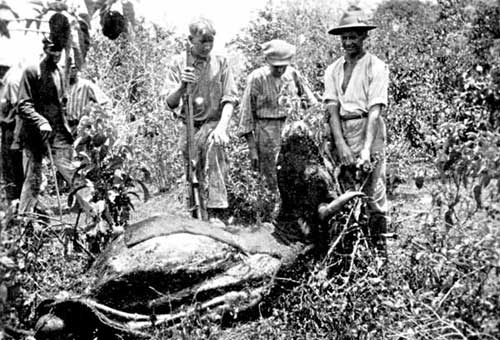
The men snatch Stampa's rifle. They are in the majority and he offers no resistance, but when he is ordered to jump into his boat and disappear, he refuses. He wants the rifle and the meat returned. Next, Phillipson fires several shots hitting the ground next to him. Stampa, who now becomes really scared, dives into the bushes while the baroness shouts more orders—he assumes she is demanding him caught or killed.
The colonists on Isla Santa Cruz regularly came to Floreana to hunt cattle. It was during such a trip that Stampa got into a quarrel with the baroness and her men. The picture was taken in 1927 and shows Albemarle colonists visiting. Kristian Stampa (far left) is the guide. The others are Leif Pettersen (with gun), his father Karl Pettersen, and Hugo Stray. The ox is partly skinned and covered with flies. Photo courtesy of Robert Ødegård, Tønsberg.
The sun has set and Stampa escapes, thanks to the darkness. He is convinced that his life is in jeopardy and he has no idea how many men and what kind of equipment this woman commands. He dares not stay near Post Office Bay, but flees to the Ritters at “Friedo.” For fear of meeting the baroness' men, he avoids the path and runs through the brush.
By the time that Stampa arrives at “Friedo,” several hours have passed. He is badly bruised, is studded with thorns and spines, is bleeding from cuts and abrasions. His clothes are torn to rags and he has lost his shoes. He is still very scared and exhausted. Dr. Ritter cleans and bandages Stampa's wounds. The next day he goes to see the baroness himself. In the meantime one of her men has been up in the highlands and determined that their own calves are still alive and well. It ends with a half-hearted apology to Stampa.
After that episode Ritter sends a letter to the governor stating that he is convinced that the baroness is not only an imposter but, according to his medical opinion, is also insane and suffering from megalomania. He demands to have her removed from the island and placed in an asylum as soon as possible.
The governor does not take Dr. Ritter's letter seriously—the German himself is considered as quite an eccentric. Besides, the baroness has already entered into an alliance with local politicians. Even before she settles on “her” island, Ecuador's newspapers print major stories about the aristocratic lady from Europe and her plans to build a luxury hotel on Galápagos. This was good publicity for the country—more work and currency for a desperately poor nation.
Hacienda Paradiso
The sheet metal roofing of the hotel gave scant evidence of luxury, but as the baroness announced to her occasional guests, this was only the beginning. Meanwhile, the main attraction was her own famous personality and fascinating background. Entertainment consisted of her accounts either about life among nobility in Europe or Hollywood's film stars. Whatever one else might think of this strange woman, there was no doubt that she was a clever speaker and gifted narrator. Also she was fluent in half a dozen languages. At Casa Matriz in Post Office Bay, a pencilled notice invited all visitors to “Hacienda Paradiso:”
Whoever you are—friends!
Two hours from here is hacienda “Paradise.” It is a spot where the tired traveller has the happiness to find peace, refreshment and quiet on his way through life.
Life—this small portion of eternity, which is bound to a clock, is so short—so then let us be happy—let us be good!
In Paradise you have only one name—friend!
We will share with you the salt of the sea, the vegetables of our garden and fruits of our trees, the cold water which runs down our cliffs, and the good things friends brought us when they passed by.
We will spend one or two moments of life with you and give you that happiness and peace that God planted in our hearts and souls when we left the restless metropolis and journeyed to the quiet of the ages, which has spread its cloak over the Galápagos!
(Signed) Baroness Wagner-Boquet.
For one and a half years the baroness “reigned” on Floreana. It was a hectic, dramatic time which has fascinated many and given material for several books.
For Rudolf Lorenz the 18 months at “Hacienda Paradiso” became pure hell. During the first weeks he was the baroness' darling, and she apparently had enough love and energy to satisfy both her men. All three slept in the same room, something the other two couples on the island considered scandalous. But slowly, the slender Lorenz was being edged out, to the advantage of the muscular Philippson. A few months later he was kept more or less as a servant or slave. Often he was beaten and mistreated, forced to carry heavy loads from Post Office Bay and to work in the fields during the hottest time of the day. He became emaciated and developed a hollow cough, probably a sign of tuberculosis. By the end of January 1933 he pleaded with Captain Allan Hancock, the owner of Velero III, an American luxury yacht which often visited the Galápagos Islands at that time of year, to take him away from the island so that he could work his way home to Paris. But Captain Hancock, the multi-millionaire owner of the ship, did not grant his wish.
For the time being, Rudolf Lorenz gave up his plans to escape and continued his slave-like existence, which became even more disagreeable when Knud Arends appeared on the scene as the baroness' “Master Hunter.”
After the death of Paul Bruun, his partner Arends eventually got Norge in working order again. He resumed fishing, but was continually hampered by accidents and problems. When Manuel J. Cobos was taken over by the local government and renamed San Cristóbal, the price for freighting bacalao increased threefold. Knud Arends gave up. For the time being he settled on San Cristóbal, accepted occasional work and hoped to save enough money to be able to return to Denmark.
Some months after the episode with Stampa and the two calves, the governor finally decided to enquire into Ritter's complaints about the baroness. Knud Arends spoke Spanish and German fluently and came along as interpreter.
A kind of court hearing was held at “Paradiso,” while the entire company was fed and entertained by the baroness. Ritter's accusations were rejected and vaguely explained by the host—and that was the end of that! At the governor's invitation the baroness and Philippson came aboard the schooner and went across to San Cristóbal. When they returned with more equipment and several animals, Arends also came along, now employed as Master Hunter. The salary was 90 sucres per month.
Now it was the young and good-looking Dane's turn to be the favorite of the baroness. Daily the two went “hunting” but seldom returning with prey. Philippson became more and more jealous. The Wittmers, who by this time had moved into their house directly above “Hacienda Paradiso,” could not avoid hearing loud screaming and quarreling. The baroness knew how to hurt. Once she caused an ugly gash on Philippson's face using her horse whip. Another time she threw a plate full of hot soup at him. Without any concern for the man's pains, she left “Paradise” to go hunting with Arends.
Philippson took out his anger on Lorenz. In his time of need, the miserable man frequently visited “Friedo” and the Wittmers, begging for food and consolation. Later, Dore wrote that she felt he was near death with malnutrition and physical and psychological abuse.
Paradise's latest attraction was hunting trips with the baroness and Master Hunter Arends in charge. In September 1933 two German tourists and a couple of Ecuadorian soldiers participated in one such hunting party. One of the Germans, a sculptor named Linde, was an unusually handsome and muscular man in his late twenties.
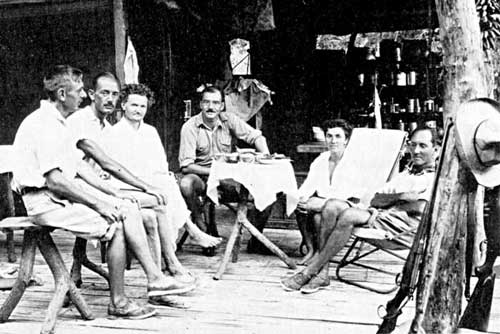
The hunt was arranged so that a feral bull was chased past the hidden hunters. As the beast eventually appeared, two shots were heard. The animal rushed on but Arends half stood up before dropping down with a groan, hit by a shot in the stomach.
A hunting party visits “Friedo” shortly before Arends is shot. From left to right: Knut Arends, an unidentified person,§ Friedrich Ritter, Werner Böckmann (a German journalist), Dore Strauch and Böckmann's brother-in-law, the sculptor Linde. Photo courtesy of Arne Falck-Rønne, Denmark.
§ The unidentified person may be J. F. Schimpff.
Dr. Ritter was summoned and concluded that the bullet had entered the abdomen after having grazed the forearm. To judge from the appearance of the wound, he was sure that it had come from a small bore weapon. All had rifles and revolvers of large caliber—with the exception of one. On that occasion the baroness had chosen a .22 caliber rifle, normally unsuitable for big game hunting. Up to now she had accused one of the soldiers in the hunting party, but now had to admit that it was she who had fired the accidental shot. She changed her behavior dramatically, cried and pronounced her grief, and in spite of Ritter's protests, she embraced and kissed the wounded Arends.
Arends had great pain and was convinced that he would die up there in Floreana's wilderness. But Ritter was of the opinion that with absolute rest and good care one could avoid complications of hemmorhage and peritonitis.
For four days Arends lay in the jungle before San Cristóbal arrived, as previously arranged, to fetch the guests. The Dane was carefully carried the eight to nine kilometers down to the coast. Finally he arrived in Guayaquil, where he was operated on and had the bullet successfully removed.
How was it possible for the baroness, who was an excellent shot, to miss a large bull and hit Arends instead? Dore and Friedrich had one explanation they thought likely. They knew from Lorenz's reports, that the baroness had a predilection for wounding animals in the legs and afterwards nursing them back to health. That is why she had chosen a small bore rifle. However, it was not Arends she was after but rather the man next to him, the handsome sculptor Linde!
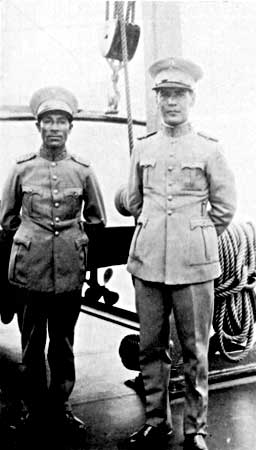
The situation at “Paradise” became progressively worse for Lorenz and he looked more sickly than ever. Those who visited the island shook their head and wondered how long the baroness could persevere in her strange conduct. The Monsunen (Monsoon) from Denmark arrived and aboard, among others, was Hakon Mielche. With Trygve Nuggerud as guide he visited all the colonists and in his book, Monsunens Siste Rejse (“Monsoon's Last Voyage,”—published in English as Let's See if the World is Round) described in cynical, aptly chosen words, the strange people who had settled on Floreana. The book's long chapter on Galápagos ends with the following:
When Ritter and the baroness each have levelled each other to ground, when “Paradise” and “Eden” (Dore preferred the name “Eden” to “Friedo”) have descended into an incinerating hell, Wittmer will still sit outside his cosy little house and smoke his well-worn pipe. The sun will rise and set and he will forget to count the days. And this man's house is not named “El Dorado!”
One wonders if Hakon Mielche was a clairvoyant. He certainly was a good judge of character.
The Governor—el Jefe Teretorial—for Galápagos in 1933-34 was Major Manuel Tomás Saguilera (on the left) and his assistant—el Ayudante Teniente—Flavio C. Muñoz Zamora. Photo courtesy of John S. Garth, Los Angeles.
In July 1934 Trygve Nuggerud with his boat Dinamita is also a guide for another Scandinavian, Rolf Blomberg. The young Swede is travelling around to write, sketch and collect insects. When they go ashore at Post Office Bay in Floreana, they see a piece of paper tacked to the mail barrel. The writing is bleached by the sun but still easy to read:
A jung man in the interior here is forced to leave the island, because he has no longer any more a living here. Therefore he begs every shyp for an occasion to take him off to Chatham or Guayaquil. I live by caverne, way marked road (red), 1 auer to go.
27 May 34
Rudolf Lorenz
The English is awkward, but Lorenz is clearly desperate to get away from the island. The party heads for the interior and finds Lorenz with the Wittmer family. He is thin and looks very ill, but is glad to see visitors. He immediately asks for a place aboard Dinamita so that he can escape from Floreana.
Enquiring about the baroness, the surprised visitors are informed that she and Philippson disappeared one day in late March. Rifles, luggage and personal belongings were also gone. Possibly they left on an English yacht.
Lorenz considered “Hacienda Paradiso” to be his property because the house was constructed with his money; therefore, he dismantled it and sold the roofing sheets and construction material to the Ritters and Wittmers.
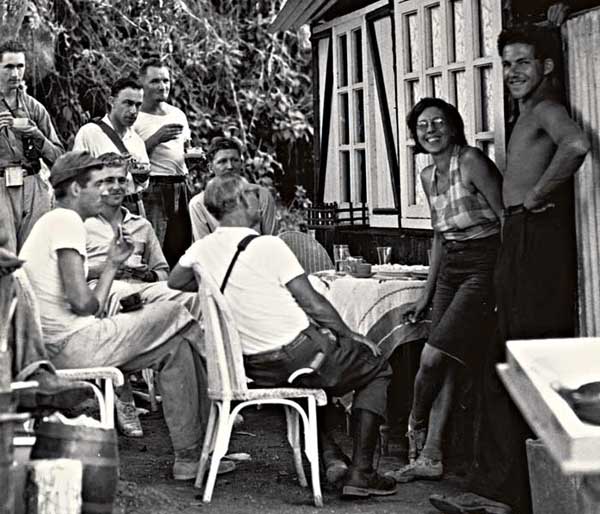
January 28, 1934: Captain Allan Hancock (seated on the chair to the right) and a group from his Velero III are entertained by the baroness and Robert Philippson at “Hacienda Paradiso.” Hollywood film director Emory Johnson was along to screen-test the baroness for a story written by herself. The movie was to be titled Empress of Floreana, but it turned out the baroness was not suited to be a movie actress. Photo courtesy of the Allan Hancock Foundation, Los Angeles.
Everyone on the island is happy to be rid of the baroness and all the fuss associated with her. One can now concentrate on surviving a terrible drought affecting the islands.
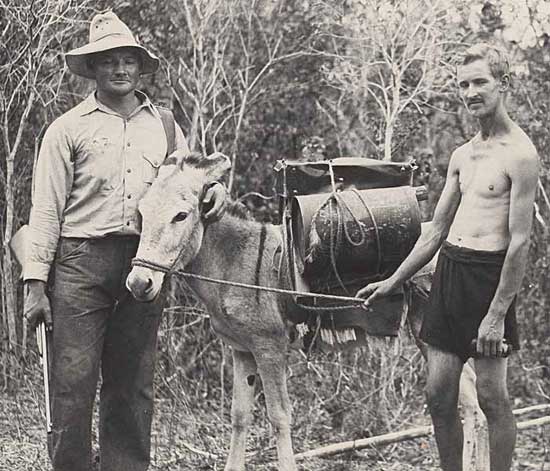
Nuggerud is willing to take Lorenz and his few belongings away from the island. But first they go to “Friedo” where Dore is hardly willing to speak to Lorenz. Later she explains that she believed Lorenz has killed his tormentors. She may understand his motives but does not wish any contact with him when “he has blood on his hands.”
Rudolf Lorenz (right) was abused and sick in January, 1934. Here he is with zoologist Fred Ziesenhenne from Velero III. The picture also shows how drinking water was transported on Floreana. Photo courtesy of John S. Garth, Los Angeles.
On the way down to the boat, Ritter and Blomberg discuss what might have happened. Ritter was in unusually good spirits; obviously happy having gotten rid of the baroness, and very soon also the pathetic Lorenz. His theory about the baroness is that when she realized that “Paradise” was a big fiasco, when animals and plants perished in the severe drought, and when they ran out of drinking water, she first chose to kill Philippson and then commit suicide. Both the Ritters and the Wittmers heard shots one night in late March or early April, so this seems to be the most logical explanation.
When they arrive in Santa Cruz, Lorenz is very restless. From Dinamita they observed the schooner San Cristóbal beating her way eastward without entering Academy Bay. She is underway with a cargo of sulfur from Port Villamil on Isabela, and is heading for Wreck Bay before continuing to the continent.
Lorenz sees an opportunity to get to Guayaquil quickly. He begs Nuggerud to take him to Wreck Bay, but the Norwegian is unwilling. He no longer carries sail for Dinamita and the wind is blowing strong from the east. The engine has been unreliable, failing lately and he does not have much gasoline. Besides, it is Friday the 13th. Why not wait until next time the schooner makes its round trip?
But Lorenz knows that months can pass before he gets another chance. He is in a hurry and also points to the mail bag that he has brought from Floreana and which he promised to take to Guayaquil. Maria Nuggerud is expecting a baby and is already at the midwife's across in San Cristóbal. When Lorenz offers a handsome amount of sucres for the trip, “Nuggen” is finally persuaded to take him to Wreck Bay.
Blomberg stays behind in Santa Cruz as Gordon Wold's guest. He wishes Nuggerud God speed and good luck with the baby before Dinamita chugs off trailing a dinghy. In addition to Nuggerud and Lorenz, a 12 year old black boy is aboard, José Pasmino. The date is Friday July 13, 1934.
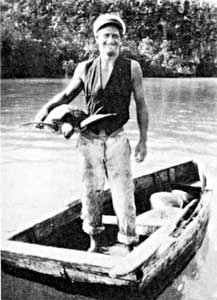
One week later a sailboat arrives in Santa Cruz from San Cristóbal. Enquiring about Dinamita, Blomberg and the others learn that the boat has not been in Wreck Bay, and that nobody has seen either Nuggerud or Lorenz. Kristian Stampa and Rolf Blomberg now start a search with Stampa's small Falcon. But because of a severe shortage of gasoline, they dare not go to the most remote islands to the north, and all attempts to find Dinamita fail.
Trygve Nuggerud with a turtle. He stands in his home-made dinghy in Academy Bay, Isla Santa Cruz. Photo courtesy of John S. Garth, Los Angeles.
Four months pass before the next scene is set in this tragedy.
On November 19, dramatic news travels around the world: The American tuna boat Santo Amaro reports over the wireless to Los Angeles that two days earlier they observed an erect pole on the northwest coast of Marchena Island—one of the more northerly islands in the Galápagos group. On the beach they found a small rowboat, and next to it the bodies of a man and a fair-haired women.
With this news the world press concludes that here is the missing baroness and her lover. Together with the bodies were a lot of letters which the captain of Santo Amaro took with him and mailed. He left the bodies undisturbed.
One of the letters was from Ritter to Captain Allan Hancock, who had planned to be in Galápagos again in January on his fourth Pacific Expedition with Velero III. Some days later Hancock gets the letter which has laid so long on Marchena's black beach:
…the baroness and Philippson have vanished to the South Seas… we hope you can come once more to the island. Then I will tell you what I cannot write, for I have no proof of it…
Hancock gets Velero III ready to sail in record time and on November 23 the ship speeds at 33 knots from Los Angeles. On Sunday December 12, the boat anchors off Marchena and they row ashore to identify the corpses.
They are in no doubt. This is not the baroness and Philippson but the mummified remains of Trygve Nuggerud and Rudolf Lorenz. Lorenz' long, fair hair is bleached white from the sun and this explains why the captain of Santo Amaro thought that he was a women.
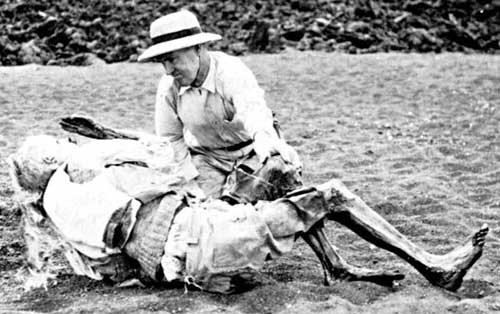
On the beach lay the remains of sea lions and marine iguanas which they must have killed and used as food to survive. Evidently they died of thirst, not of starvation. When the two were first found, Nuggerud had the dinghy overturned across him. He was lying as if fallen asleep with his head on a rolled-up blanket. His right hand was clutching a rope, and his shoes were neatly placed in front of his head. Lorenz, lying some meters away, looked as if he had plunged, head first, into the sand. Consequently, Nuggerud must have died first.
Lorenz had been dead for many weeks on waterless, sun-scorched Isla Marchena when his nearly mummified body was found. As Velero III pursor Bob Irwin looks at Lorenz, it seems as if the German defends himself against the suspicion that he murdered the baroness and Philippson. Photo courtesy of John S. Garth, Los Angeles.
Hancock's group think it strange that the sickly and skinny Lorenz should have survived the healthy, strong Norwegian. He must have had more will to live than one might have assumed.
The same evening aboard Velero III the zoologist, John Garth, one of the members of Hancock's expedition, writes the following in his diary:
While I looked at Lorenz' body, I wondered if I stared into the face of the murderer of the baroness and Philippson. If the miserable wretch's situation was even worse than when we visited him on Floreana, he might have been sufficiently provoked. But what a punishment to befall him while fleeing from his criminal act, and how absurd that an innocent man should become involved in such a cruel death.
Dinamita and the 12-year-old José Pasmino were never found.
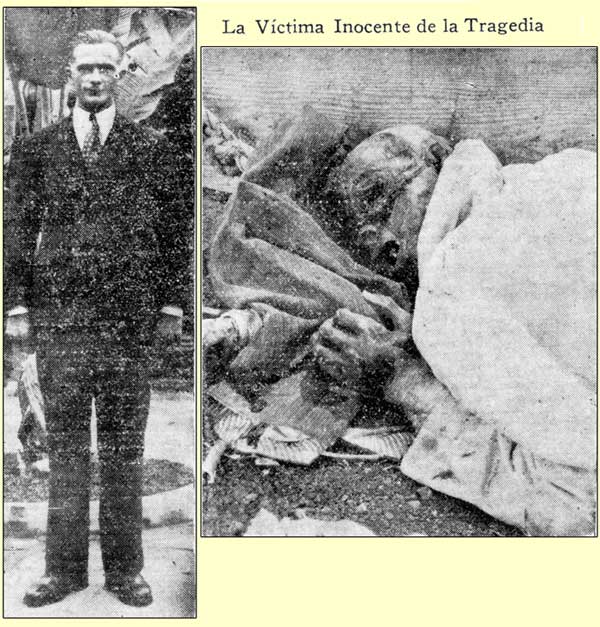
There are many theories as to what had happened, but the most probable one is that the engine failed or they ran out of gasoline and that the current took them north instead of eastward, just as Stampa and Blomberg had assumed when they were out searching. When their boat drifted near Marchena, the two men chose to row ashore in the dinghy, taking with them mail and valuables. Parhaps the black boy thought that the larger boat was a safer place and continued in it northward in the hope of being found.
Nuggerud and Lorenz were not buried on Marchena before February, 1935. On Monday, February 18, the Guayaquil newspaper El Universo had a large spread, captioned “The Tragedy's Innocent Victim” and the following report:
With a cry of pain on his lips and fists clenched powerlessly, Trygve Nuggerud was caught by death after a long suffering. The pain, caused by thirst, was gruesomely expressed by the twisted body, which left an unforgettable impression. … He was the innocent victim in the tragedy! A cruel and unfair fate led to this terrible death! To the left is the photograph of the unhappy Norwegian, taken in Montalvo Park in town. On the back of the original is a simple message to his wife María Rodríguez: “With greetings from Nuggerud.”
On December 4, Velero III anchors off Black Beach Road. A mirror flashes a message to them from “Friedo.”
Allan Hancock and four other men hurry along and meet Margret Wittmer at the gate. “I am afraid there's bad news,” she told him. “Dr. Ritter died three weeks ago. It's been a great shock for Miss Dore, and I am looking after her.”
Friedrich Ritter also died in a horrible way. Lack of food at “Friedo” had made living difficult during the persistent drought, and long ago the vegetarian Ritter had to forsake his principles in the fight for survival. Some canned pork was tainted and inedible. He fed it to the chickens with the result that they all died. Thus the food situation was made even more critical. Therefore, Friedrich decided that the dead chickens should be preserved. Provided they were boiled thoroughly, the original poison should become detoxified.
Dore says that she was totally against this, but Ritter still ate his preserved boiled chickens a few days later. Shortly after the meal he developed abdominal colic then increasing paralysis. [The symptoms suggest botulism poisoning. Normally, the toxins should have been made harmless by cooking, as Dr. Ritter claimed. Possibly a new colony of bacteria developed on canning—unless he was poisoned by Dore.] Dore fetched the Wittmers who thus were witnesses to Friedrich's last hours. When they arrived, he had already lost the ability to speak and could hardly breathe, but he was fully conscious.
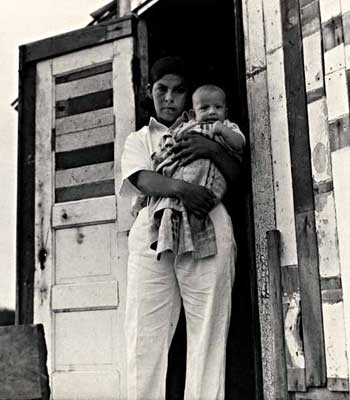
The two women's descriptions of Ritter's last moments are very different. Dore says she consoled her dying hero and he answered her love with thankful eyes. Margret Wittmer says that Friedrich's eyes were full of hatred when he stared at Dore, and that he tried to hit and kick her when she approached. While he still could move his fingers, he wrote in great pain:
“I curse you with my dying breath.”
Trygve Nuggerud never lived to see his son. Maria and baby Oscar Trygve on Isla Santa Cruz, December 1934. Photo courtesy of the Allan Hancock Foundation, Los Angeles.
Dore Strauch left for Guayaquil aboard Velero III. On the way they stopped at Santa Cruz before sailing eastward to the continent.
Outside a multicolored hut behind the factory John Garth noticed a local woman with a chubby baby in her arms. He was surprized by the baby's fair skin. When he approached, he noticed that the eyes were blue.
He was told that the little one's name was Oscar Trygve Nuggerud.

